
ShannonBase
The Next-Gen Database for AI—an infrastructure designed for data and AI. As the MySQL of the AI era.
Stars: 58
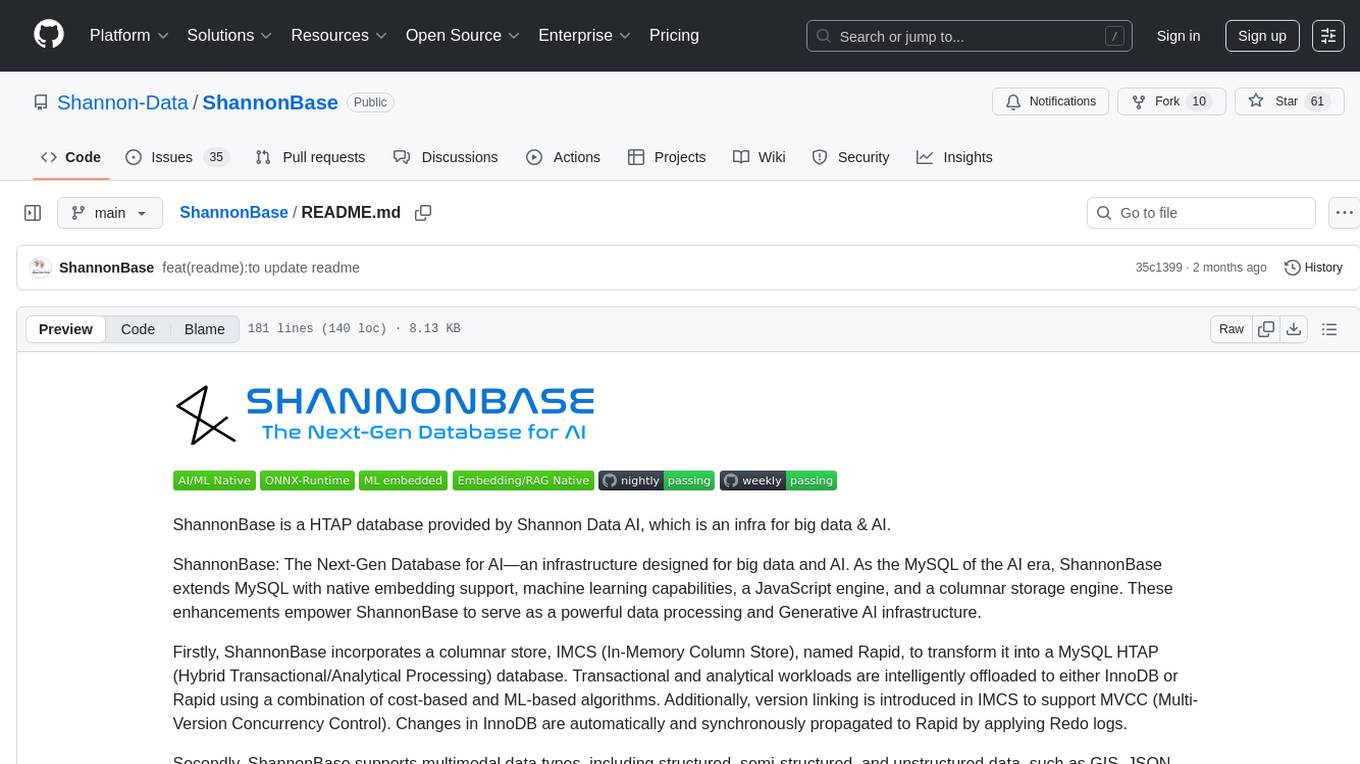
ShannonBase is a HTAP database provided by Shannon Data AI, designed for big data and AI. It extends MySQL with native embedding support, machine learning capabilities, a JavaScript engine, and a columnar storage engine. ShannonBase supports multimodal data types and natively integrates LightGBM for training and prediction. It leverages embedding algorithms and vector data type for ML/RAG tasks, providing Zero Data Movement, Native Performance Optimization, and Seamless SQL Integration. The tool includes a lightweight JavaScript engine for writing stored procedures in SQL or JavaScript.
README:
ShannonBase is a HTAP database provided by Shannon Data AI, which is an infra for big data & AI.
ShannonBase: The Next-Gen Database for AI—an infrastructure designed for big data and AI. As the MySQL of the AI era, ShannonBase extends MySQL with native embedding support, machine learning capabilities, a JavaScript engine, and a columnar storage engine. These enhancements empower ShannonBase to serve as a powerful data processing and Generative AI infrastructure.
Firstly, ShannonBase incorporates a columnar store, IMCS (In-Memory Column Store), named Rapid, to transform it into a MySQL HTAP (Hybrid Transactional/Analytical Processing) database. Transactional and analytical workloads are intelligently offloaded to either InnoDB or Rapid using a combination of cost-based and ML-based algorithms. Additionally, version linking is introduced in IMCS to support MVCC (Multi-Version Concurrency Control). Changes in InnoDB are automatically and synchronously propagated to Rapid by applying Redo logs.
Secondly, ShannonBase supports multimodal data types, including structured, semi-structured, and unstructured data, such as GIS, JSON, and Vector.
Thirdly, ShannonBase natively supports LightGBM or XGBoost (TBD), allowing users to perform training and prediction directly via stored procedures, such as ml_train, ml_predict_row, ml_model_import, etc.—eliminating the need for ETL (exporting data and importing trained ML models). Alternatively, pre-trained models can be imported into ShannonBase to save training time. Classification, Regression, Recommendation, Abnormal detection, etc. supported.
Fourthly, By leveraging embedding algorithms and vector data type, ShannonBase becomes a powerful ML/RAG tool for ML/AI data scientists. With Zero Data Movement, Native Performance Optimization, and Seamless SQL Integration, ShannonBase is easy to use, making it an essential hands-on tool for data scientists and ML/AI developers.
At last, ShannonBase Multilingual Engine Component. ShannonBase includes a lightweight JavaScript engine, JerryScript, allowing users to write stored procedures in either SQL or JavaScript.
git clone --recursive [email protected]:Shannon-Data/ShannonBase.git
PS: You should ensure that your prerequisite development environment is properly set up.
cd ShannonBase && mkdir cmake_build && cd cmake_build
cmake ../ \
-DWITH_BOOST=/path-to-boost-include-files/ \
-DCMAKE_BUILD_TYPE=[Release|Debug] \
-DCMAKE_INSTALL_PREFIX=/path-to-shannon-bin \
-DMYSQL_DATADIR=/home/path-to-shannon-bin/data \
-DSYSCONFDIR=. \
-DMYSQL_UNIX_ADDR=/home/path-to-shannon-bin/tmp/mysql.sock \
-DWITH_EMBEDDED_SERVER=OFF \
-DWITH_MYISAM_STORAGE_ENGINE=1 \
-DWITH_INNOBASE_STORAGE_ENGINE=1 \
-DWITH_PARTITION_STORAGE_ENGINE=1 \
-DMYSQL_TCP_PORT=3306 \
-DENABLED_LOCAL_INFILE=1 \
-DEXTRA_CHARSETS=all \
-DWITH_PROTOBUF=bundled \
-DWITH_SSL_PATH=/path-to-open-ssl/ \
-DDEFAULT_SET=community \
-DWITH_UNIT_TESTS=OFF \
[-DENABLE_GCOV=1 \ |
-DWITH_ASAN=1 \ |
]
-DCOMPILATION_COMMENT="MySQL Community Server, and Shannon Data AI Alpha V.- (GPL)"
make -j5 && make install
PS: in [], it's an optional compilation params, which is to enable coverage collection and ASAN check. And, boost asio
files are needed, you should install boost asio library at first.
To activate support for the Lakehouse feature, which allows ShannonBase to read Parquet format files, configure the build with the CMake option -DWITH_LAKEHOUSE=system. This setting integrates the required Lakehouse dependencies and enables Parquet file processing capabilities within the ShannonBase.
/path-to-shannbase-bin/bin/mysqld --defaults-file=/path-to-shannonbase-bin/my.cnf --initialize --user=xxx
/path-to-shannbase-bin/bin//mysqld --defaults-file=/path-to-shannonbase-bin/my.cnf --user=xxx &
PS: you should use your own my.cnf.
To create a test table with secondary_engine set to Rapid and load it into Rapid, use the following SQL commands:
CREATE TABLE test1 (
col1 INT PRIMARY KEY,
col2 INT
) SECONDARY_ENGINE = Rapid;
ALTER TABLE test1 SECONDARY_LOAD;
If you want to forcefully use Rapid, use:
set use_secondary_engine=forced;
ShannonBase supports GIS data types for storing and querying spatial data.
CREATE TABLE locations (
id INT PRIMARY KEY,
name VARCHAR(100),
coordinates POINT NOT NULL
);
INSERT INTO locations (id, name, coordinates) VALUES
(1, 'Beijing', ST_GeomFromText('POINT(116.4074 39.9042)')),
(2, 'Shanghai', ST_GeomFromText('POINT(121.4737 31.2304)')),
(3, 'Guangzhou', ST_GeomFromText('POINT(113.2644 23.1291)')),
(4, 'Shenzhen', ST_GeomFromText('POINT(114.0579 22.5431)')),
(5, 'Chengdu', ST_GeomFromText('POINT(104.0665 30.5728)'));
SELECT name FROM locations WHERE ST_X(coordinates) BETWEEN 110 AND 120 AND ST_Y(coordinates) BETWEEN 20 AND 40;
ShannonBase allows efficient JSON storage and querying.
CREATE TABLE users (
id INT PRIMARY KEY,
name VARCHAR(100),
details JSON
);
INSERT INTO users (id, name, details)
VALUES (1, 'Alice', '{"age": 30, "email": "[email protected]", "preferences": {"theme": "dark"}}');
SELECT details->>'$.email' AS email FROM users WHERE details->>'$.preferences.theme' = 'dark';
ShannonBase natively supports Vector data types for AI and ML applications.
CREATE TABLE embeddings (
id INT PRIMARY KEY,
description TEXT,
embedding VECTOR(10)) secondary_engine=rapid;
INSERT INTO embeddings (id, description, embedding)
VALUES (1, 'Example text', TO_VECTOR("[0.12, -0.34, 0.56, 0.78, -0.91, 0.23, -0.45, 0.67, -0.89, 1.23]"));
SELECT LENGTH(embedding), FROM_VECTOR(embedding) FROM embeddings WHERE id = 1;
Use native ML functions in ShannonBase to perform machine learning tasks seamlessly.
CREATE TABLE census_train ( age INT, workclass VARCHAR(255), fnlwgt INT, education VARCHAR(255), `education-num` INT, `marital-status` VARCHAR(255), occupation VARCHAR(255), relationship VARCHAR(255), race VARCHAR(255), sex VARCHAR(255), `capital-gain` INT, `capital-loss` INT, `hours-per-week` INT, `native-country` VARCHAR(255), revenue VARCHAR(255)) secondary_engine=rapid;
CREATE TABLE census_test LIKE census_train;
LOAD DATA INFILE '/path_to_data_source/ML/census/census_train_load.csv' INTO TABLE census_train FIELDS TERMINATED BY ',' ;
LOAD DATA INFILE '/path_to_data_source//ML/census/census_test_load.csv' INTO TABLE census_test FIELDS TERMINATED BY ',' ;
ALTER TABLE census_train secondary_load;
SET @census_model = 'census_test';
CALL sys.ML_TRAIN('heatwaveml_bench.census_train', 'revenue', JSON_OBJECT('task', 'classification'), @census_model);
CALL sys.ML_MODEL_LOAD(@census_model, NULL);
SELECT sys.ML_PREDICT_ROW(@row_input, @census_model, NULL);
To specify the language as JavaScript, you can create a stored procedure in JavaScript
DELIMITER |;
CREATE FUNCTION IS_EVEN (VAL INT) RETURNS INT
LANGUAGE JAVASCRIPT AS $$
function isEven(num) {
return num % 2 == 0;
}
return isEven(VAL);
$$|
DELIMITER ;|
SELECT is_even(3);
For more information, please refer to https://github.com/Shannon-Data/ShannonBase/wiki for details.
For Tasks:
Click tags to check more tools for each tasksFor Jobs:
Alternative AI tools for ShannonBase
Similar Open Source Tools

ShannonBase
ShannonBase is a HTAP database provided by Shannon Data AI, designed for big data and AI. It extends MySQL with native embedding support, machine learning capabilities, a JavaScript engine, and a columnar storage engine. ShannonBase supports multimodal data types and natively integrates LightGBM for training and prediction. It leverages embedding algorithms and vector data type for ML/RAG tasks, providing Zero Data Movement, Native Performance Optimization, and Seamless SQL Integration. The tool includes a lightweight JavaScript engine for writing stored procedures in SQL or JavaScript.
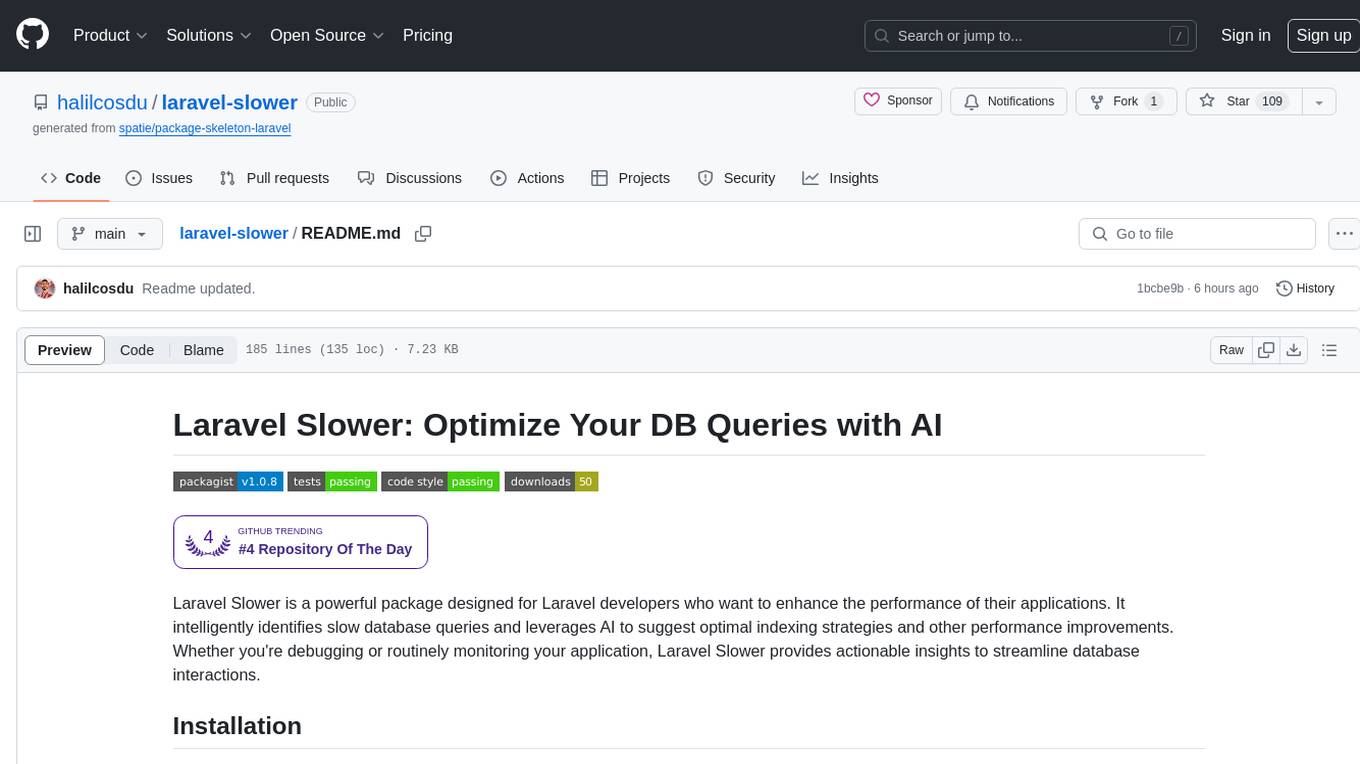
laravel-slower
Laravel Slower is a powerful package designed for Laravel developers to optimize the performance of their applications by identifying slow database queries and providing AI-driven suggestions for optimal indexing strategies and performance improvements. It offers actionable insights for debugging and monitoring database interactions, enhancing efficiency and scalability.
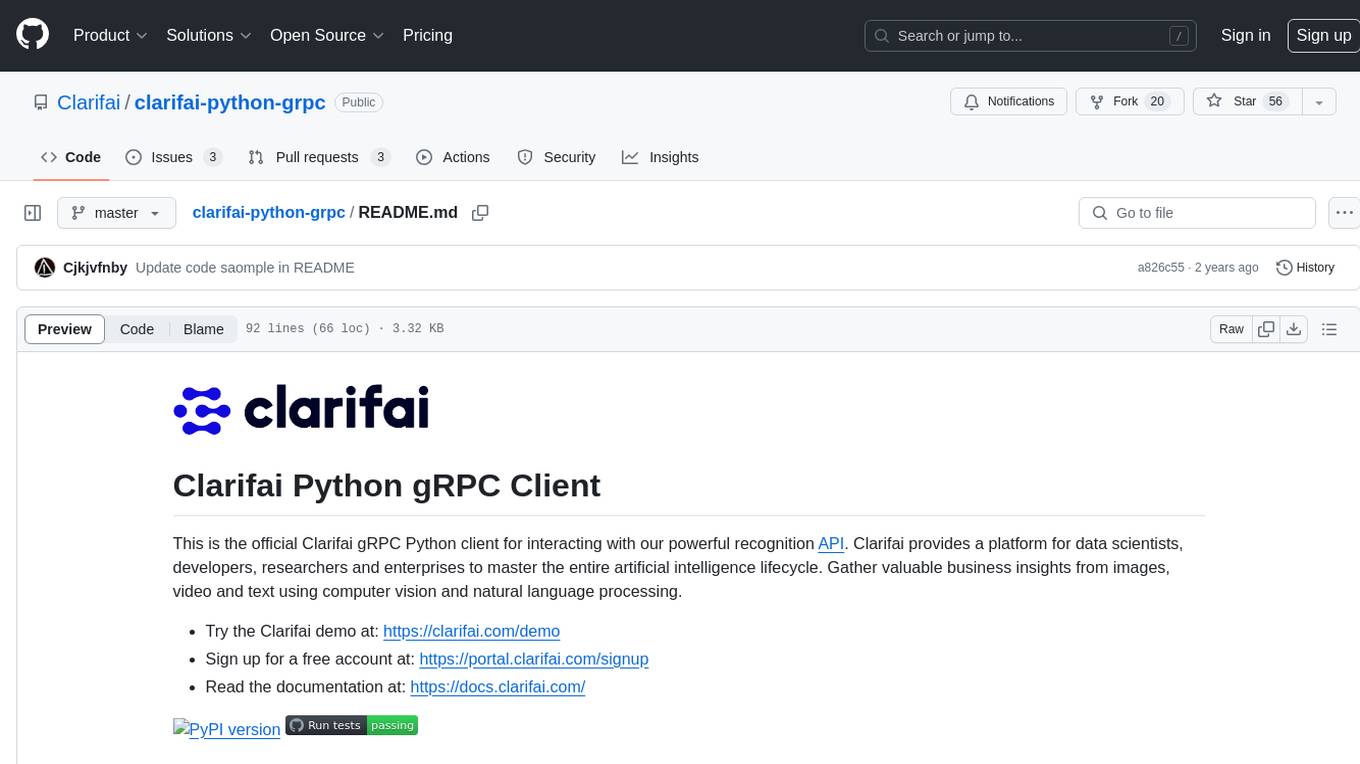
clarifai-python-grpc
This is the official Clarifai gRPC Python client for interacting with their recognition API. Clarifai offers a platform for data scientists, developers, researchers, and enterprises to utilize artificial intelligence for image, video, and text analysis through computer vision and natural language processing. The client allows users to authenticate, predict concepts in images, and access various functionalities provided by the Clarifai API. It follows a versioning scheme that aligns with the backend API updates and includes specific instructions for installation and troubleshooting. Users can explore the Clarifai demo, sign up for an account, and refer to the documentation for detailed information.
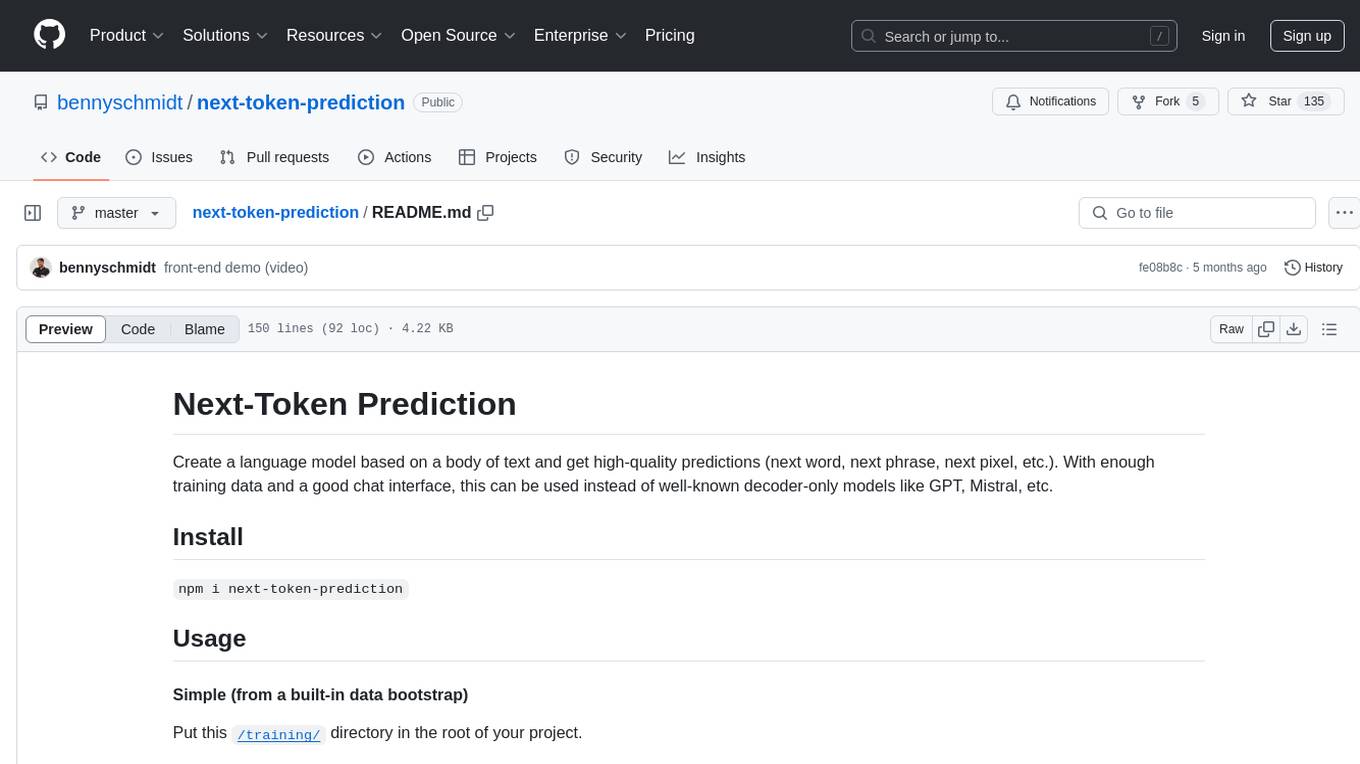
next-token-prediction
Next-Token Prediction is a language model tool that allows users to create high-quality predictions for the next word, phrase, or pixel based on a body of text. It can be used as an alternative to well-known decoder-only models like GPT and Mistral. The tool provides options for simple usage with built-in data bootstrap or advanced customization by providing training data or creating it from .txt files. It aims to simplify methodologies, provide autocomplete, autocorrect, spell checking, search/lookup functionalities, and create pixel and audio transformers for various prediction formats.
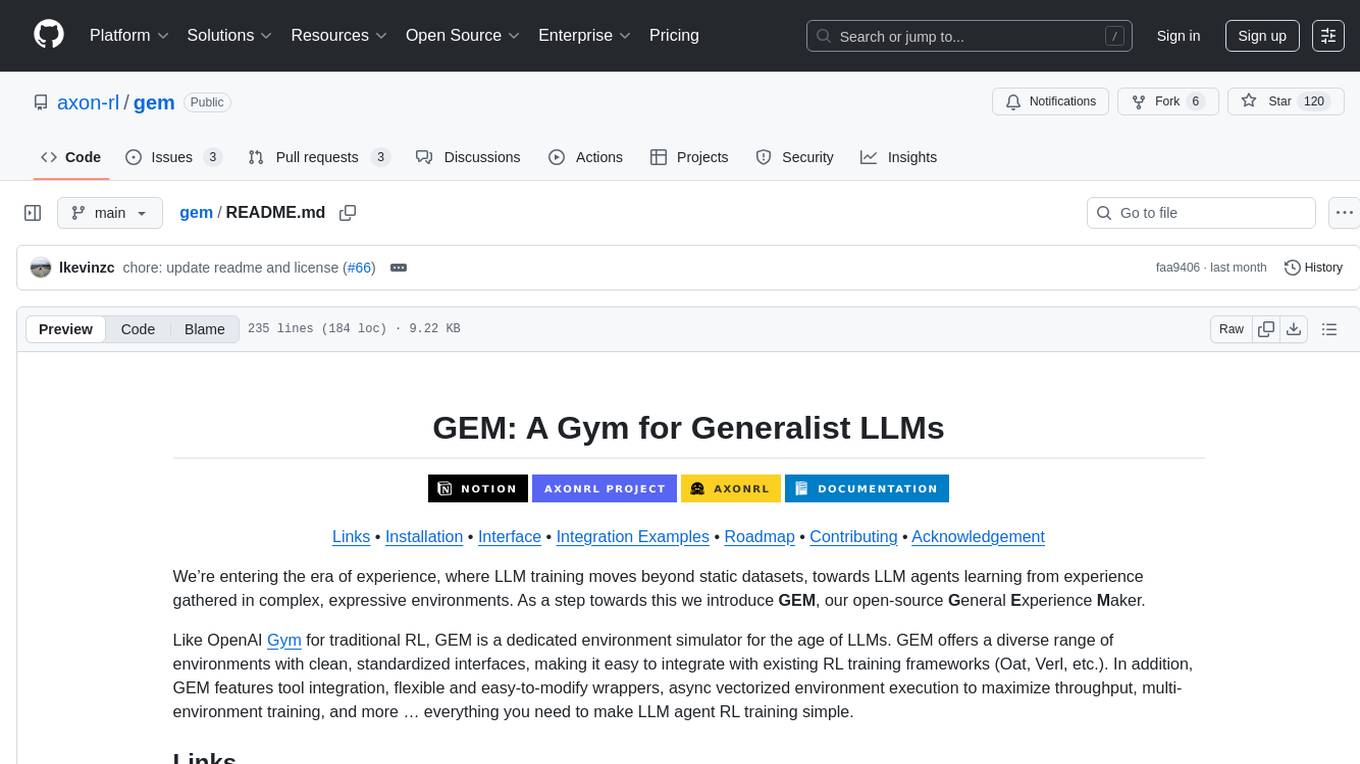
gem
GEM is an open-source General Experience Maker designed for training Large Language Models (LLMs) in dynamic environments. Similar to OpenAI Gym for traditional Reinforcement Learning, GEM provides a variety of environments with standardized interfaces for seamless integration with existing LLM training frameworks. It offers tool integration, flexible wrappers, async vectorized environment execution, multi-environment training, and more to simplify LLM agent training.
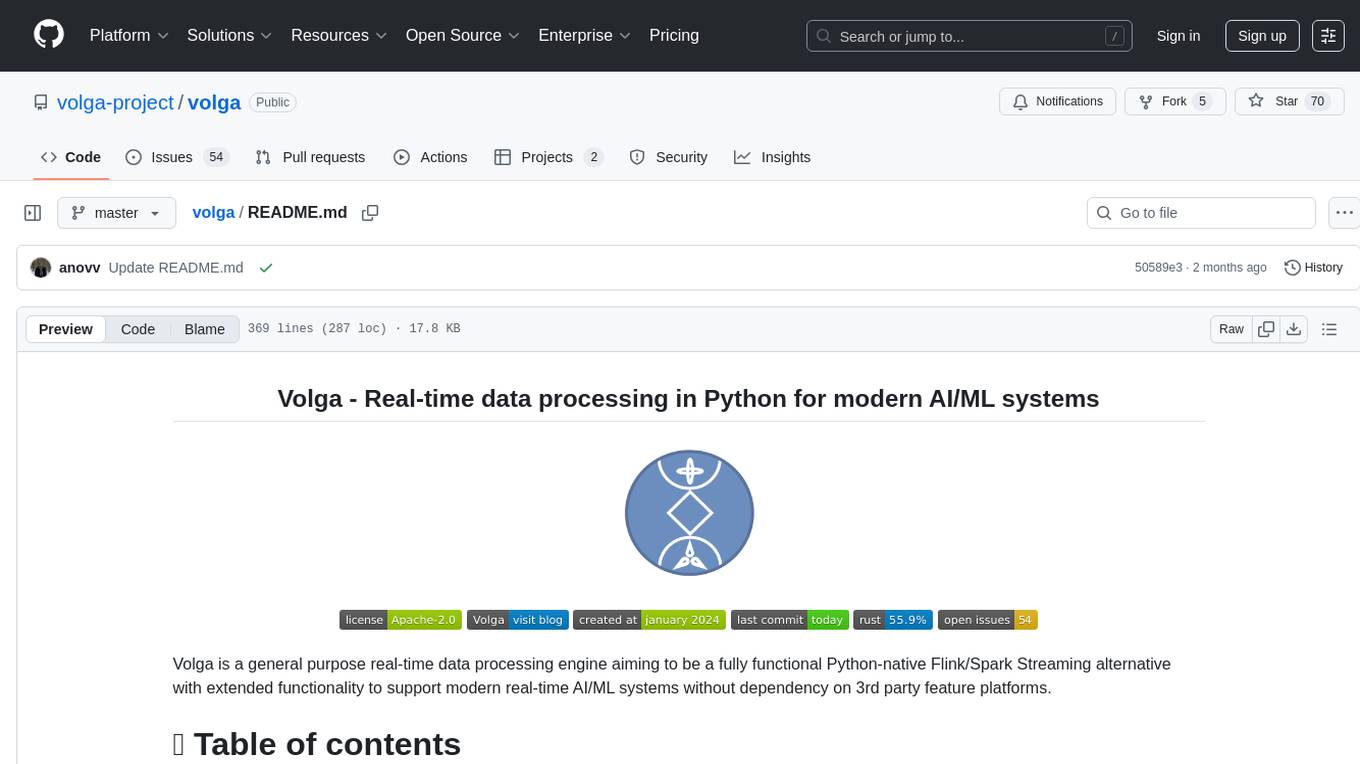
volga
Volga is a general purpose real-time data processing engine in Python for modern AI/ML systems. It aims to be a Python-native alternative to Flink/Spark Streaming with extended functionality for real-time AI/ML workloads. It provides a hybrid push+pull architecture, Entity API for defining data entities and feature pipelines, DataStream API for general data processing, and customizable data connectors. Volga can run on a laptop or a distributed cluster, making it suitable for building custom real-time AI/ML feature platforms or general data pipelines without relying on third-party platforms.
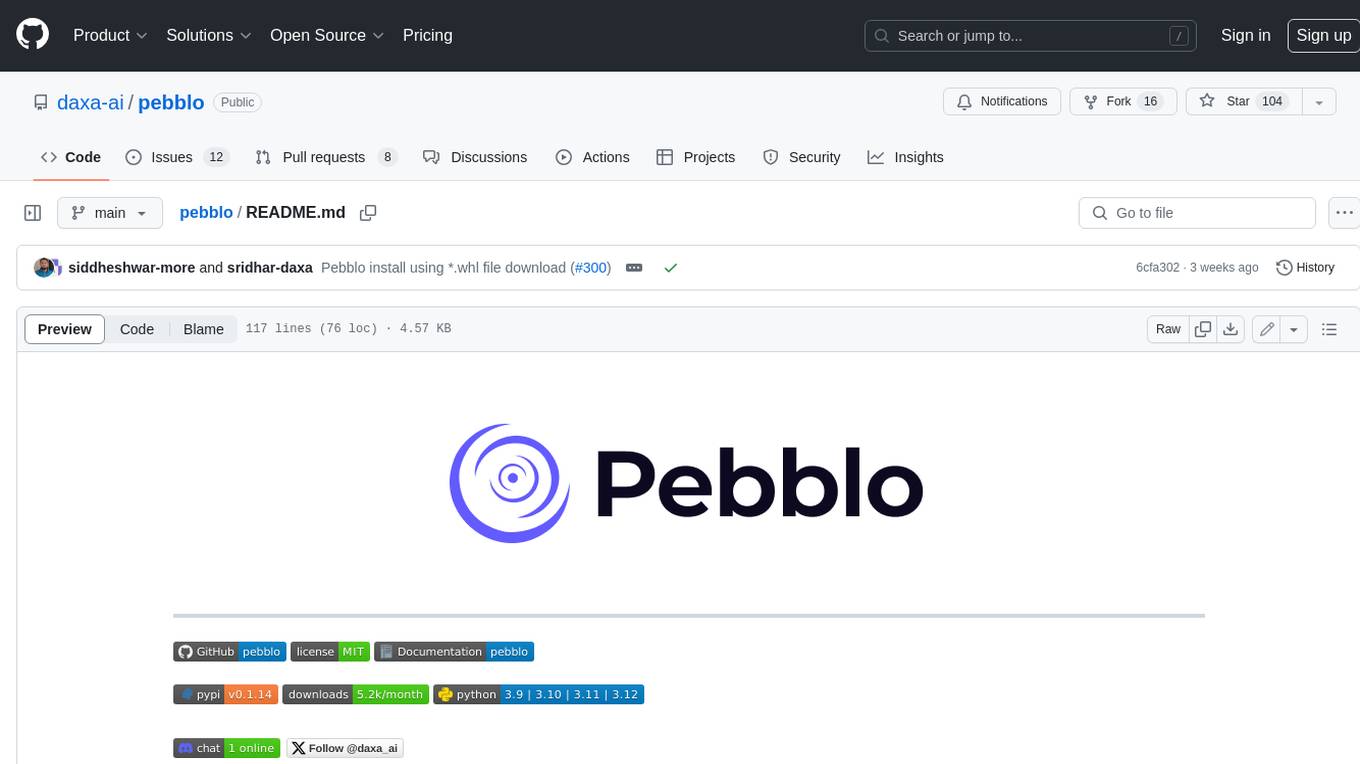
pebblo
Pebblo enables developers to safely load data and promote their Gen AI app to deployment without worrying about the organization’s compliance and security requirements. The project identifies semantic topics and entities found in the loaded data and summarizes them on the UI or a PDF report.
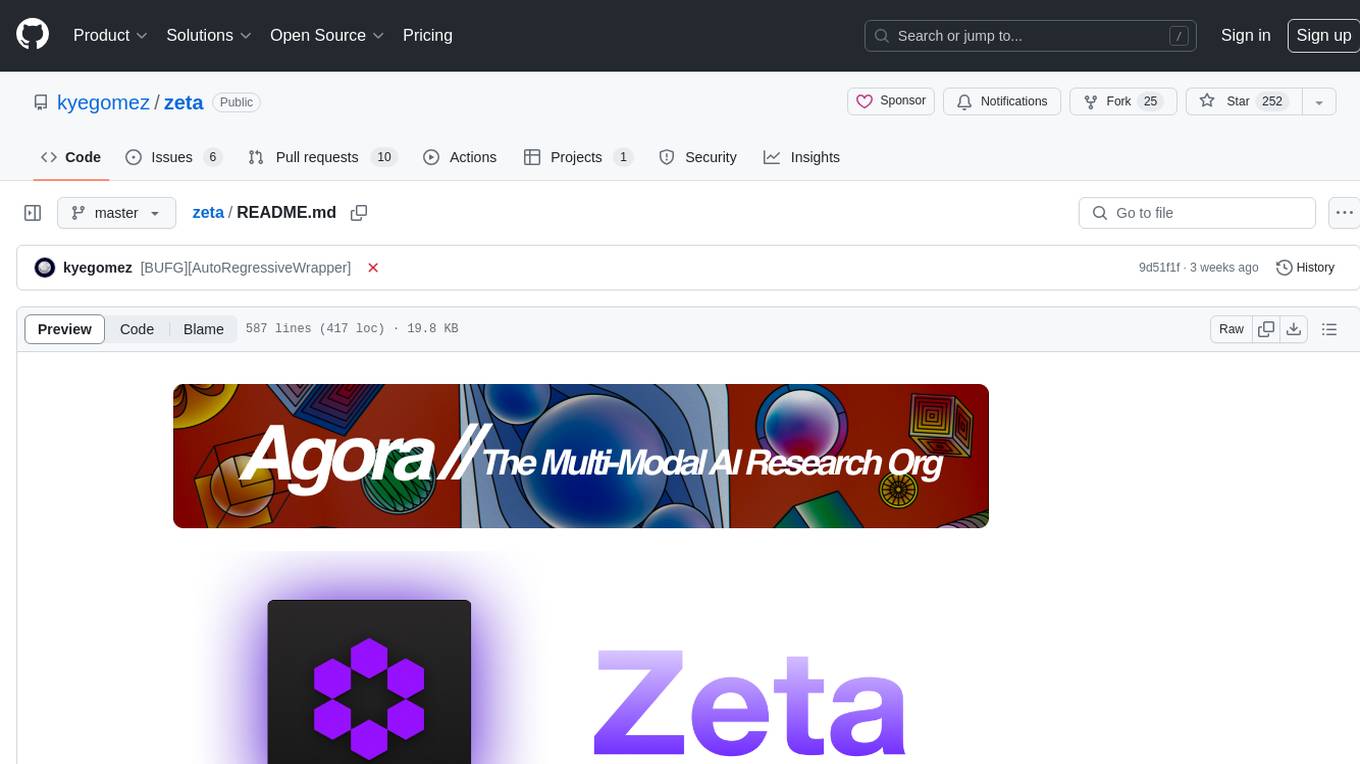
zeta
Zeta is a tool designed to build state-of-the-art AI models faster by providing modular, high-performance, and scalable building blocks. It addresses the common issues faced while working with neural nets, such as chaotic codebases, lack of modularity, and low performance modules. Zeta emphasizes usability, modularity, and performance, and is currently used in hundreds of models across various GitHub repositories. It enables users to prototype, train, optimize, and deploy the latest SOTA neural nets into production. The tool offers various modules like FlashAttention, SwiGLUStacked, RelativePositionBias, FeedForward, BitLinear, PalmE, Unet, VisionEmbeddings, niva, FusedDenseGELUDense, FusedDropoutLayerNorm, MambaBlock, Film, hyper_optimize, DPO, and ZetaCloud for different tasks in AI model development.
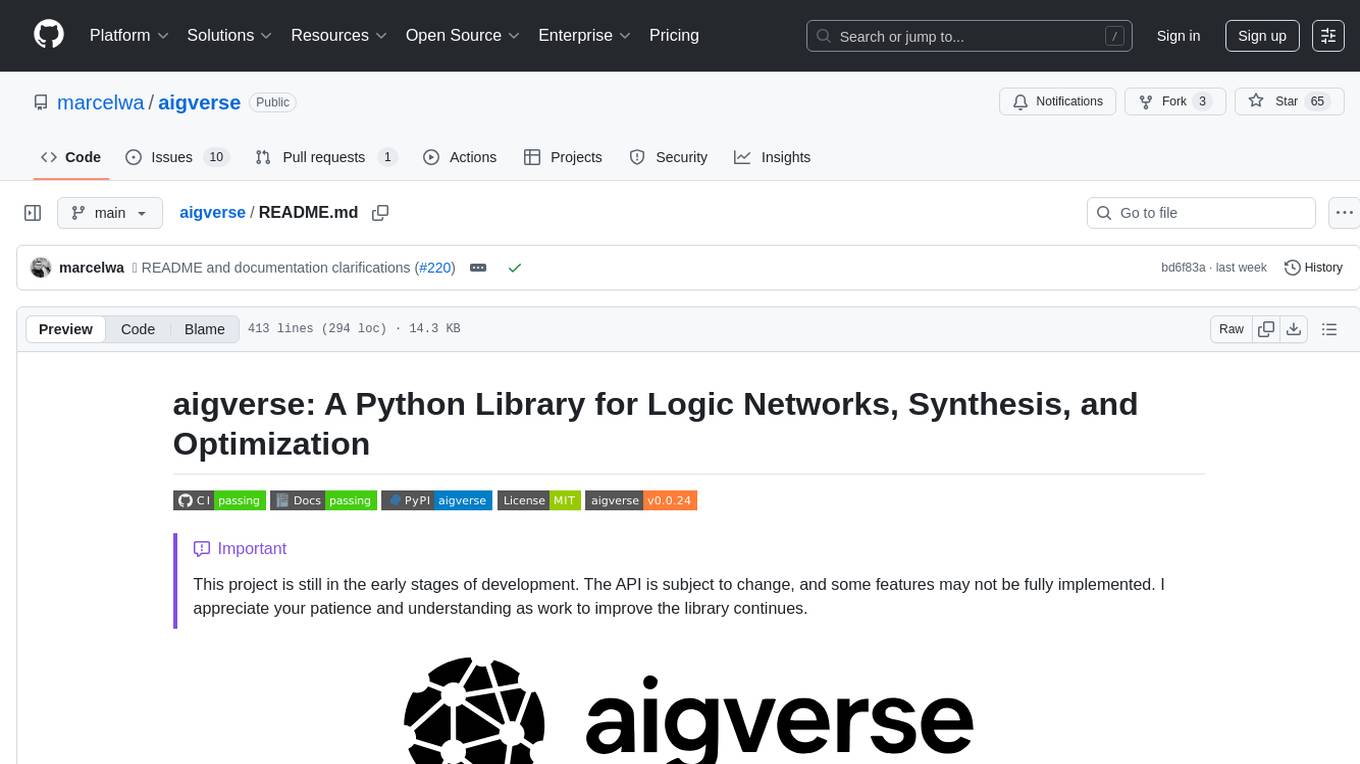
aigverse
aigverse is a Python infrastructure framework that bridges the gap between logic synthesis and AI/ML applications. It allows efficient representation and manipulation of logic circuits, making it easier to integrate logic synthesis and optimization tasks into machine learning pipelines. Built upon EPFL Logic Synthesis Libraries, particularly mockturtle, aigverse provides a high-level Python interface to state-of-the-art algorithms for And-Inverter Graph (AIG) manipulation and logic synthesis, widely used in formal verification, hardware design, and optimization tasks.
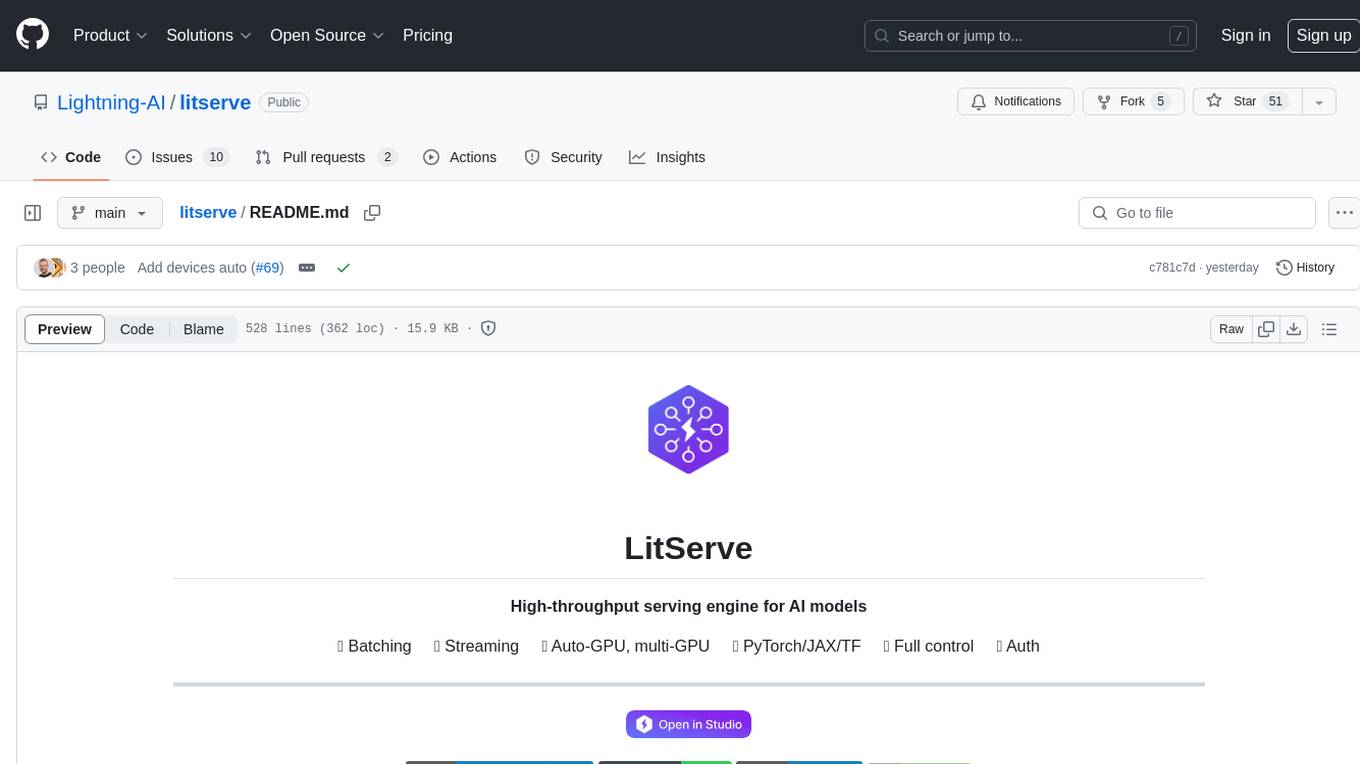
litserve
LitServe is a high-throughput serving engine for deploying AI models at scale. It generates an API endpoint for a model, handles batching, streaming, autoscaling across CPU/GPUs, and more. Built for enterprise scale, it supports every framework like PyTorch, JAX, Tensorflow, and more. LitServe is designed to let users focus on model performance, not the serving boilerplate. It is like PyTorch Lightning for model serving but with broader framework support and scalability.
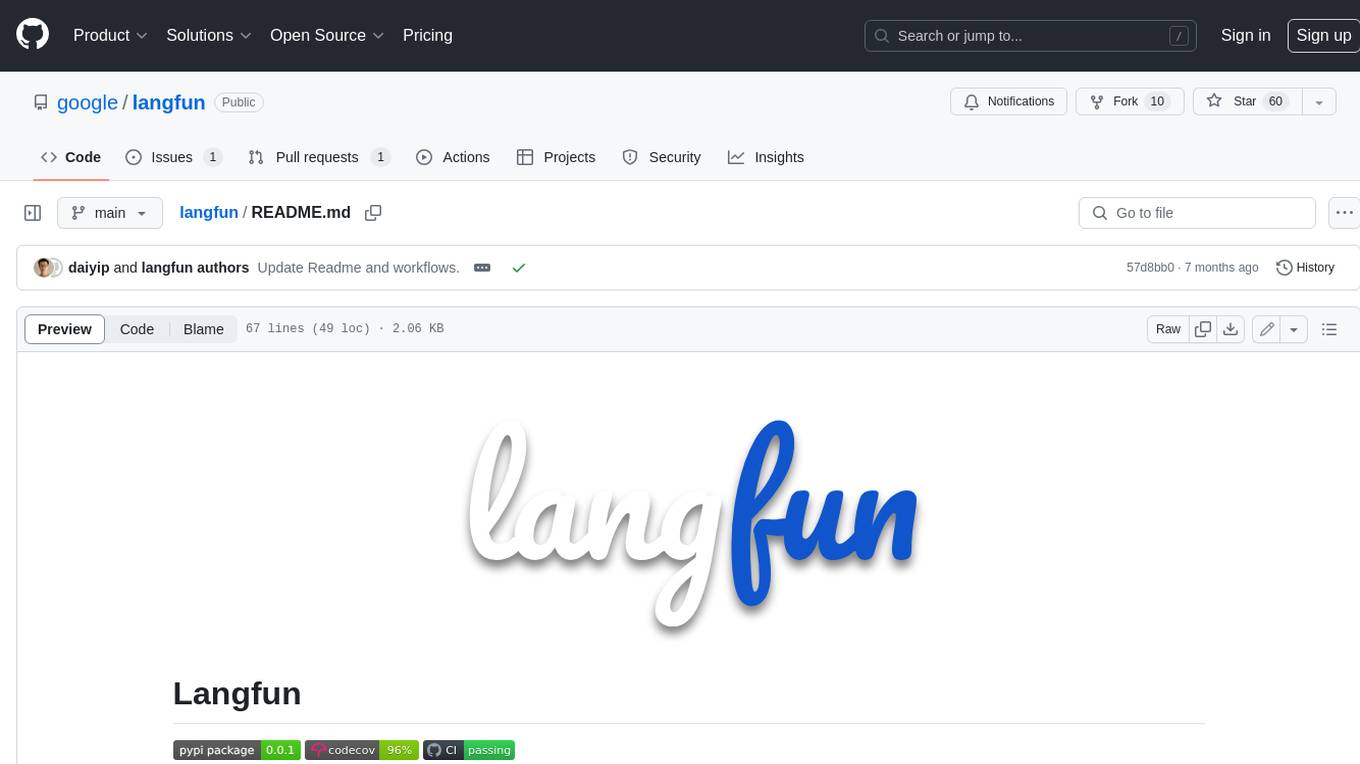
langfun
Langfun is a Python library that aims to make language models (LM) fun to work with. It enables a programming model that flows naturally, resembling the human thought process. Langfun emphasizes the reuse and combination of language pieces to form prompts, thereby accelerating innovation. Unlike other LM frameworks, which feed program-generated data into the LM, langfun takes a distinct approach: It starts with natural language, allowing for seamless interactions between language and program logic, and concludes with natural language and optional structured output. Consequently, langfun can aptly be described as Language as functions, capturing the core of its methodology.
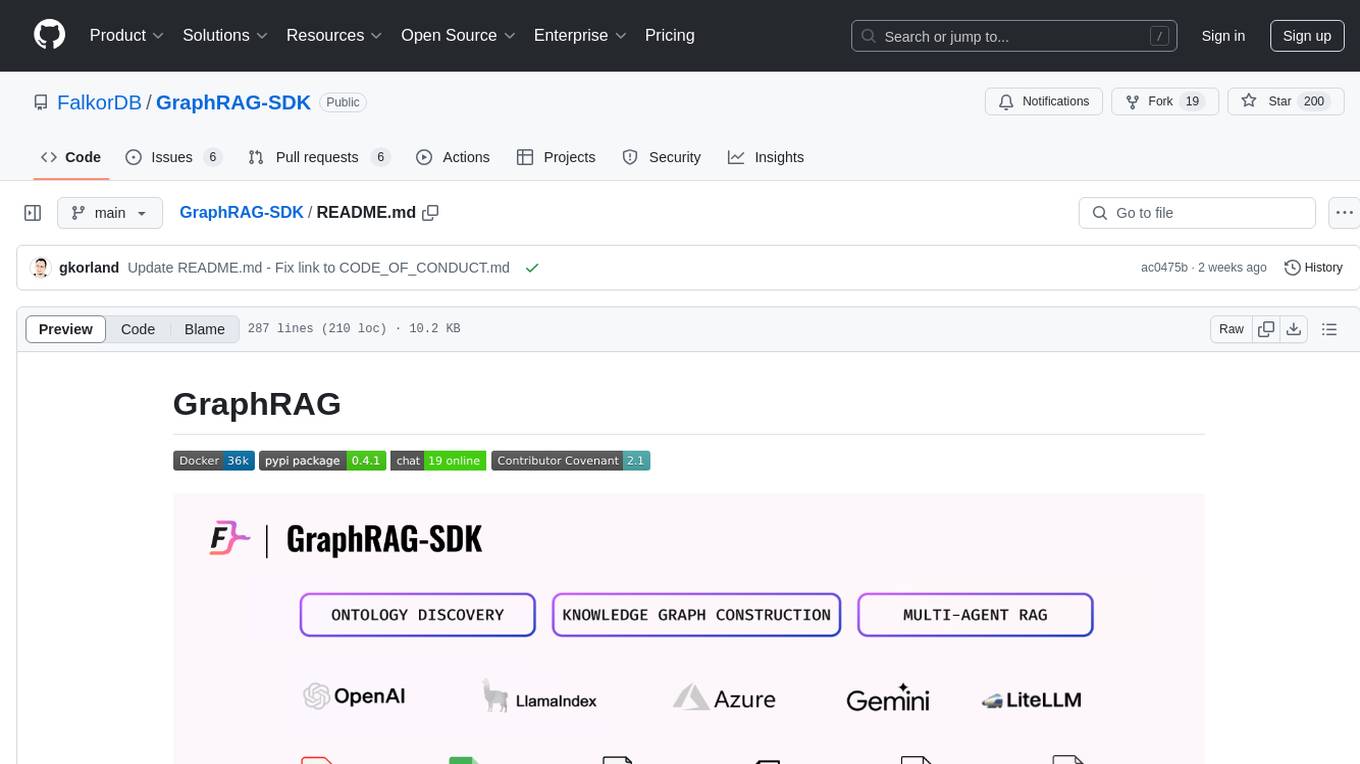
GraphRAG-SDK
Build fast and accurate GenAI applications with GraphRAG SDK, a specialized toolkit for building Graph Retrieval-Augmented Generation (GraphRAG) systems. It integrates knowledge graphs, ontology management, and state-of-the-art LLMs to deliver accurate, efficient, and customizable RAG workflows. The SDK simplifies the development process by automating ontology creation, knowledge graph agent creation, and query handling, enabling users to interact and query their knowledge graphs effectively. It supports multi-agent systems and orchestrates agents specialized in different domains. The SDK is optimized for FalkorDB, ensuring high performance and scalability for large-scale applications. By leveraging knowledge graphs, it enables semantic relationships and ontology-driven queries that go beyond standard vector similarity, enhancing retrieval-augmented generation capabilities.
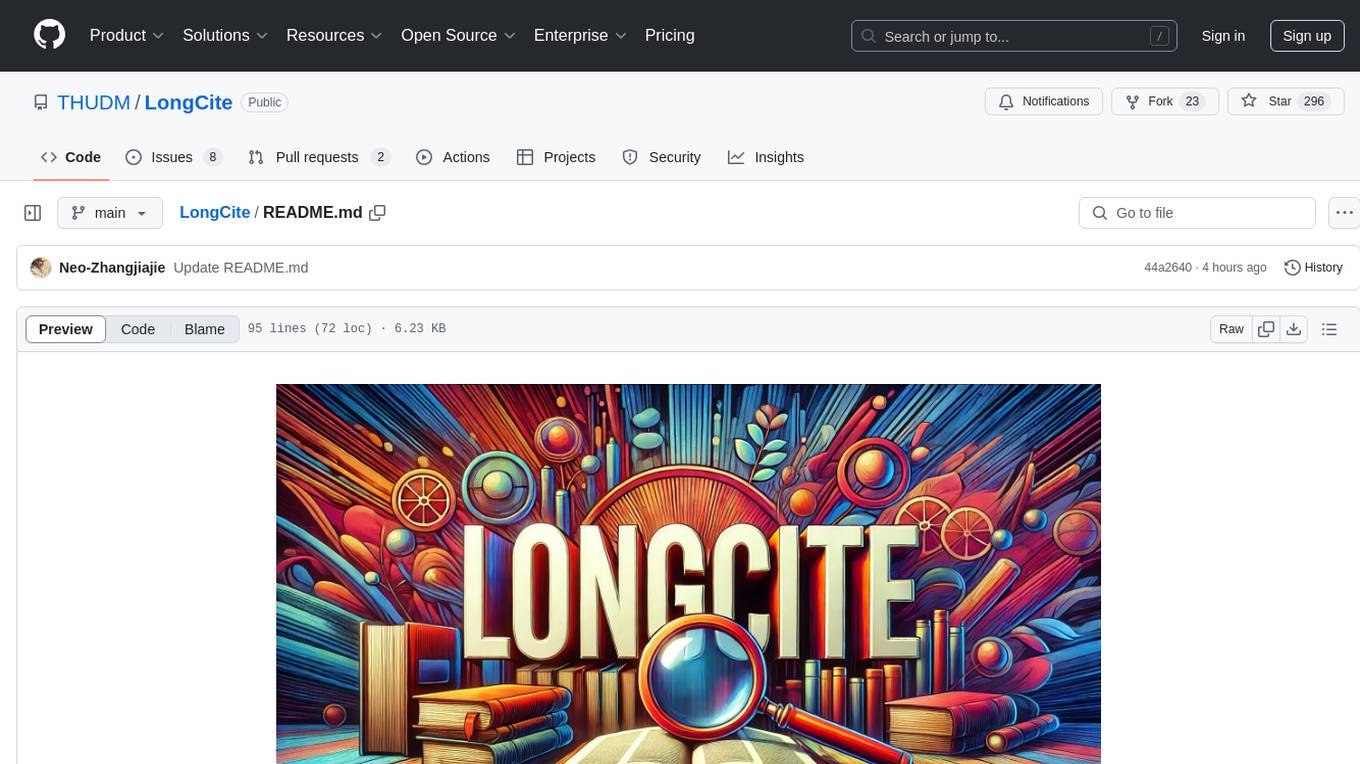
LongCite
LongCite is a tool that enables Large Language Models (LLMs) to generate fine-grained citations in long-context Question Answering (QA) scenarios. It provides models trained on GLM-4-9B and Meta-Llama-3.1-8B, supporting up to 128K context. Users can deploy LongCite chatbots, generate accurate responses, and obtain precise sentence-level citations. The tool includes components for model deployment, Coarse to Fine (CoF) pipeline for data construction, model training using LongCite-45k dataset, evaluation with LongBench-Cite benchmark, and citation generation.

simple-openai
Simple-OpenAI is a Java library that provides a simple way to interact with the OpenAI API. It offers consistent interfaces for various OpenAI services like Audio, Chat Completion, Image Generation, and more. The library uses CleverClient for HTTP communication, Jackson for JSON parsing, and Lombok to reduce boilerplate code. It supports asynchronous requests and provides methods for synchronous calls as well. Users can easily create objects to communicate with the OpenAI API and perform tasks like text-to-speech, transcription, image generation, and chat completions.
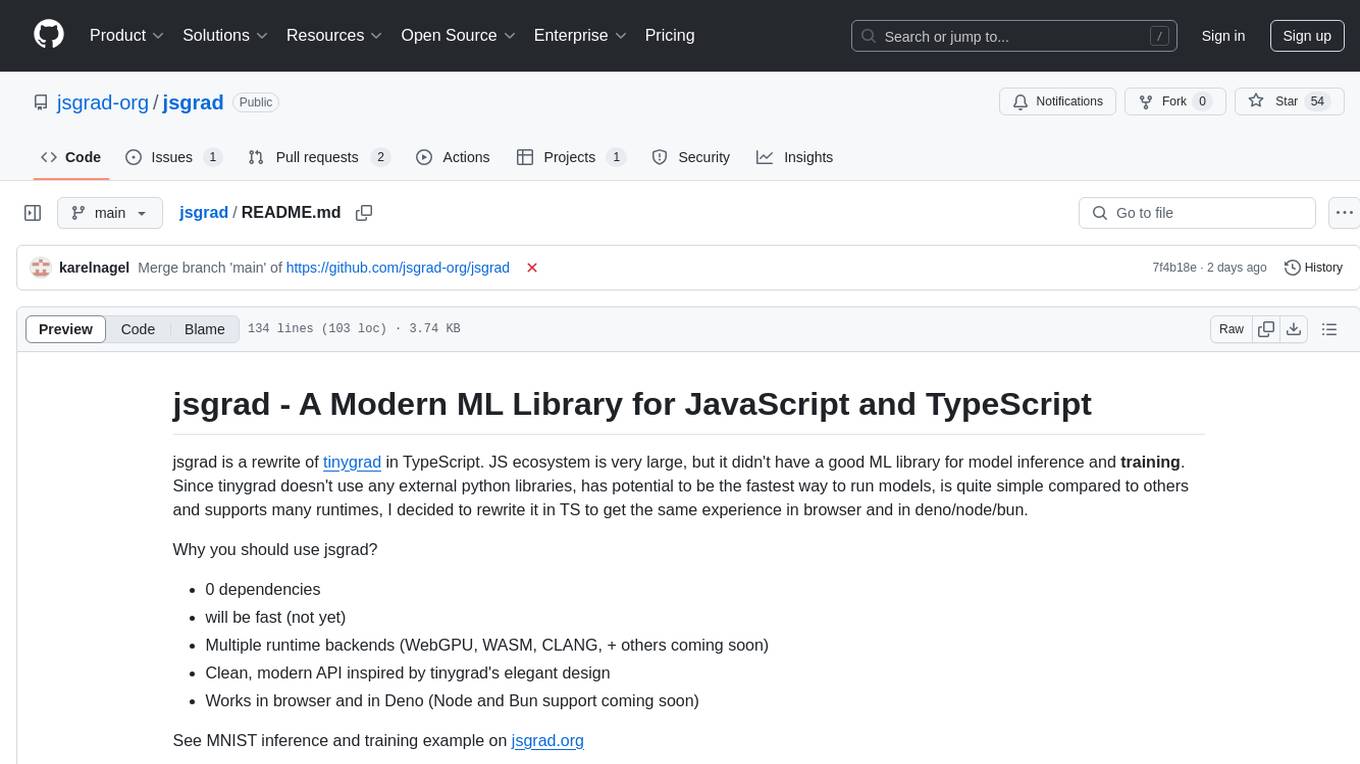
jsgrad
jsgrad is a modern ML library for JavaScript and TypeScript that aims to provide a fast and efficient way to run and train machine learning models. It is a rewrite of tinygrad in TypeScript, offering a clean and modern API with zero dependencies. The library supports multiple runtime backends such as WebGPU, WASM, and CLANG, making it versatile for various applications in browser and server environments. With a focus on simplicity and performance, jsgrad is designed to be easy to use for both model inference and training tasks.

litdata
LitData is a tool designed for blazingly fast, distributed streaming of training data from any cloud storage. It allows users to transform and optimize data in cloud storage environments efficiently and intuitively, supporting various data types like images, text, video, audio, geo-spatial, and multimodal data. LitData integrates smoothly with frameworks such as LitGPT and PyTorch, enabling seamless streaming of data to multiple machines. Key features include multi-GPU/multi-node support, easy data mixing, pause & resume functionality, support for profiling, memory footprint reduction, cache size configuration, and on-prem optimizations. The tool also provides benchmarks for measuring streaming speed and conversion efficiency, along with runnable templates for different data types. LitData enables infinite cloud data processing by utilizing the Lightning.ai platform to scale data processing with optimized machines.
For similar tasks

ShannonBase
ShannonBase is a HTAP database provided by Shannon Data AI, designed for big data and AI. It extends MySQL with native embedding support, machine learning capabilities, a JavaScript engine, and a columnar storage engine. ShannonBase supports multimodal data types and natively integrates LightGBM for training and prediction. It leverages embedding algorithms and vector data type for ML/RAG tasks, providing Zero Data Movement, Native Performance Optimization, and Seamless SQL Integration. The tool includes a lightweight JavaScript engine for writing stored procedures in SQL or JavaScript.
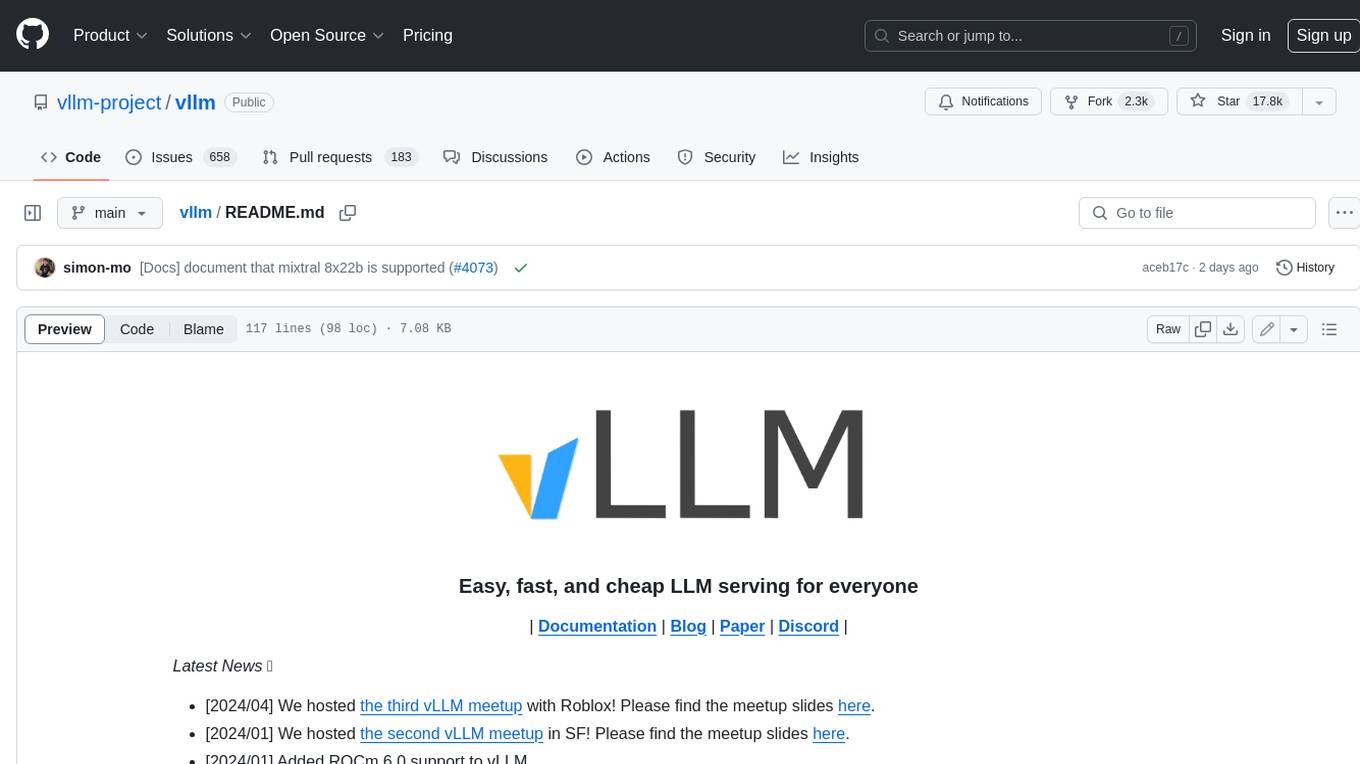
vllm
vLLM is a fast and easy-to-use library for LLM inference and serving. It is designed to be efficient, flexible, and easy to use. vLLM can be used to serve a variety of LLM models, including Hugging Face models. It supports a variety of decoding algorithms, including parallel sampling, beam search, and more. vLLM also supports tensor parallelism for distributed inference and streaming outputs. It is open-source and available on GitHub.
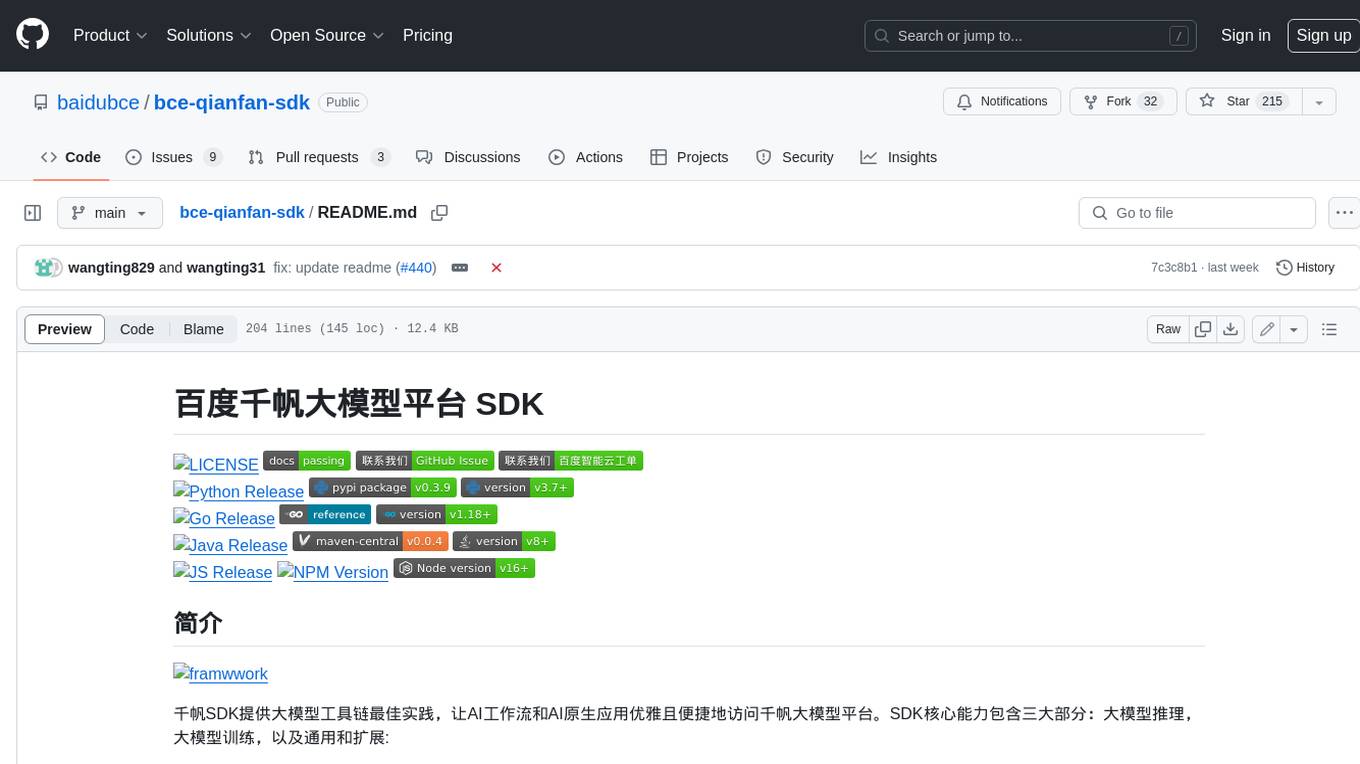
bce-qianfan-sdk
The Qianfan SDK provides best practices for large model toolchains, allowing AI workflows and AI-native applications to access the Qianfan large model platform elegantly and conveniently. The core capabilities of the SDK include three parts: large model reasoning, large model training, and general and extension: * `Large model reasoning`: Implements interface encapsulation for reasoning of Yuyan (ERNIE-Bot) series, open source large models, etc., supporting dialogue, completion, Embedding, etc. * `Large model training`: Based on platform capabilities, it supports end-to-end large model training process, including training data, fine-tuning/pre-training, and model services. * `General and extension`: General capabilities include common AI development tools such as Prompt/Debug/Client. The extension capability is based on the characteristics of Qianfan to adapt to common middleware frameworks.
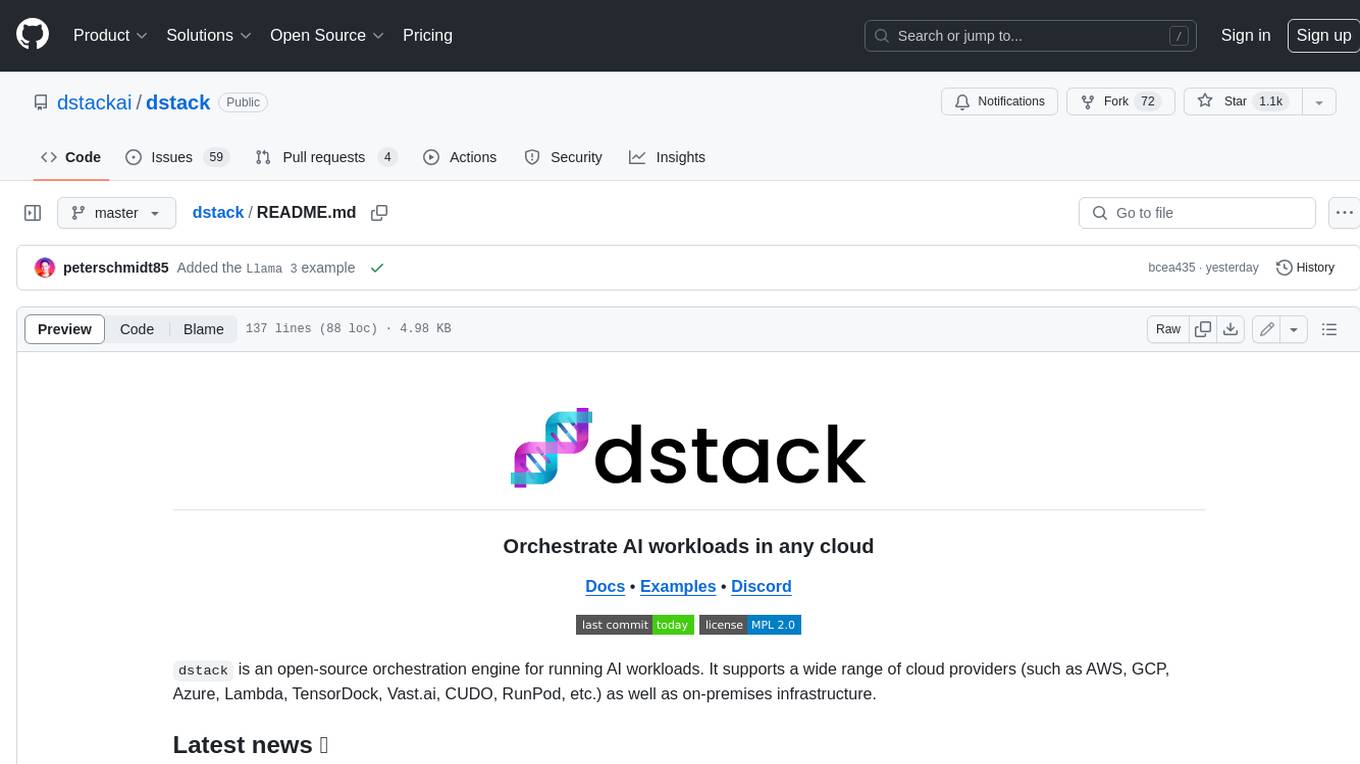
dstack
Dstack is an open-source orchestration engine for running AI workloads in any cloud. It supports a wide range of cloud providers (such as AWS, GCP, Azure, Lambda, TensorDock, Vast.ai, CUDO, RunPod, etc.) as well as on-premises infrastructure. With Dstack, you can easily set up and manage dev environments, tasks, services, and pools for your AI workloads.
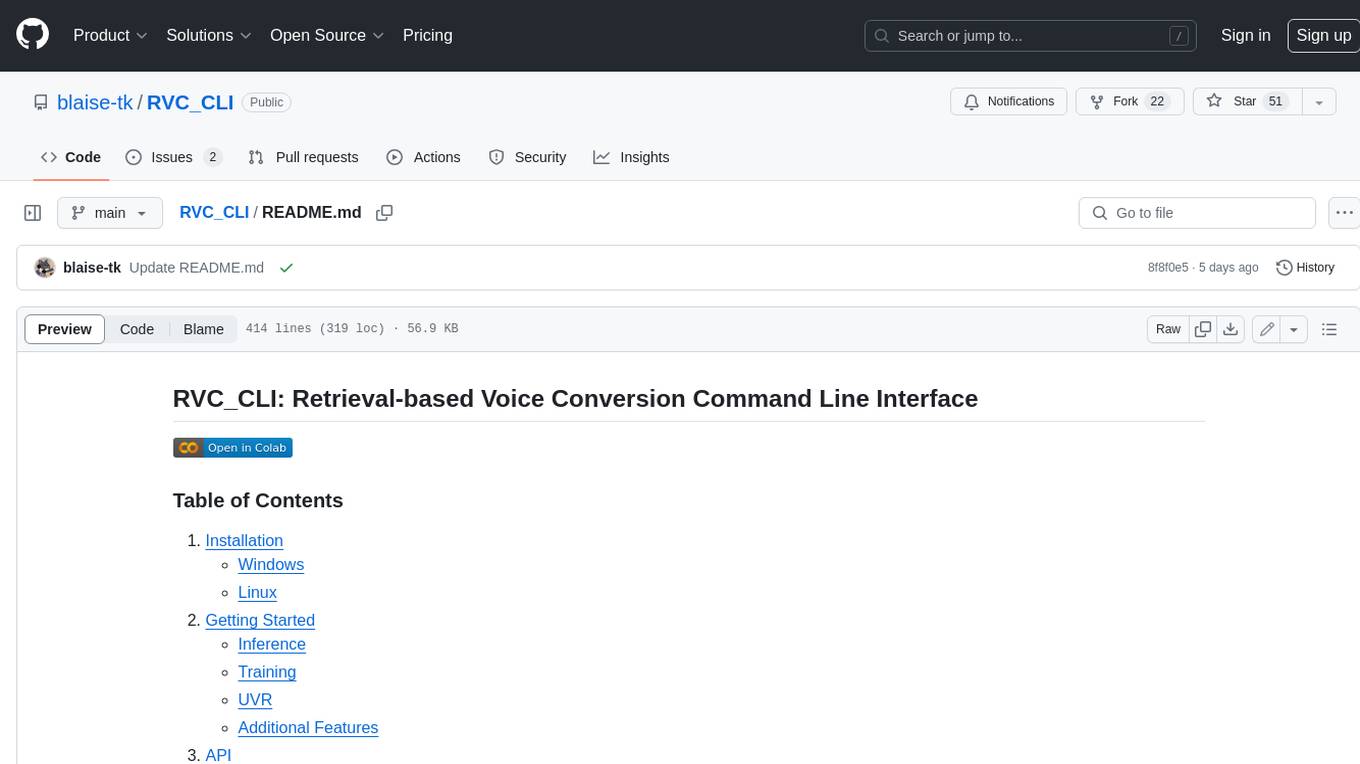
RVC_CLI
**RVC_CLI: Retrieval-based Voice Conversion Command Line Interface** This command-line interface (CLI) provides a comprehensive set of tools for voice conversion, enabling you to modify the pitch, timbre, and other characteristics of audio recordings. It leverages advanced machine learning models to achieve realistic and high-quality voice conversions. **Key Features:** * **Inference:** Convert the pitch and timbre of audio in real-time or process audio files in batch mode. * **TTS Inference:** Synthesize speech from text using a variety of voices and apply voice conversion techniques. * **Training:** Train custom voice conversion models to meet specific requirements. * **Model Management:** Extract, blend, and analyze models to fine-tune and optimize performance. * **Audio Analysis:** Inspect audio files to gain insights into their characteristics. * **API:** Integrate the CLI's functionality into your own applications or workflows. **Applications:** The RVC_CLI finds applications in various domains, including: * **Music Production:** Create unique vocal effects, harmonies, and backing vocals. * **Voiceovers:** Generate voiceovers with different accents, emotions, and styles. * **Audio Editing:** Enhance or modify audio recordings for podcasts, audiobooks, and other content. * **Research and Development:** Explore and advance the field of voice conversion technology. **For Jobs:** * Audio Engineer * Music Producer * Voiceover Artist * Audio Editor * Machine Learning Engineer **AI Keywords:** * Voice Conversion * Pitch Shifting * Timbre Modification * Machine Learning * Audio Processing **For Tasks:** * Convert Pitch * Change Timbre * Synthesize Speech * Train Model * Analyze Audio
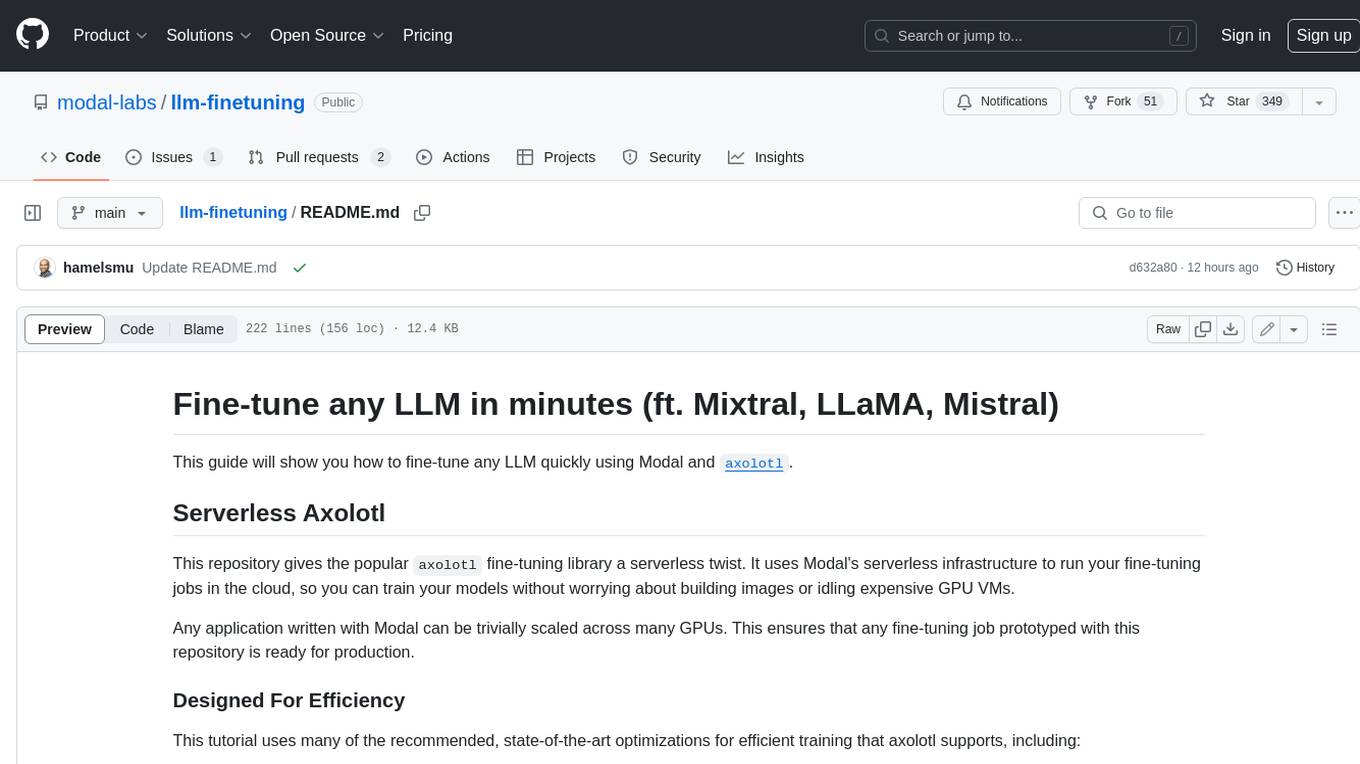
llm-finetuning
llm-finetuning is a repository that provides a serverless twist to the popular axolotl fine-tuning library using Modal's serverless infrastructure. It allows users to quickly fine-tune any LLM model with state-of-the-art optimizations like Deepspeed ZeRO, LoRA adapters, Flash attention, and Gradient checkpointing. The repository simplifies the fine-tuning process by not exposing all CLI arguments, instead allowing users to specify options in a config file. It supports efficient training and scaling across multiple GPUs, making it suitable for production-ready fine-tuning jobs.

zeta
Zeta is a tool designed to build state-of-the-art AI models faster by providing modular, high-performance, and scalable building blocks. It addresses the common issues faced while working with neural nets, such as chaotic codebases, lack of modularity, and low performance modules. Zeta emphasizes usability, modularity, and performance, and is currently used in hundreds of models across various GitHub repositories. It enables users to prototype, train, optimize, and deploy the latest SOTA neural nets into production. The tool offers various modules like FlashAttention, SwiGLUStacked, RelativePositionBias, FeedForward, BitLinear, PalmE, Unet, VisionEmbeddings, niva, FusedDenseGELUDense, FusedDropoutLayerNorm, MambaBlock, Film, hyper_optimize, DPO, and ZetaCloud for different tasks in AI model development.
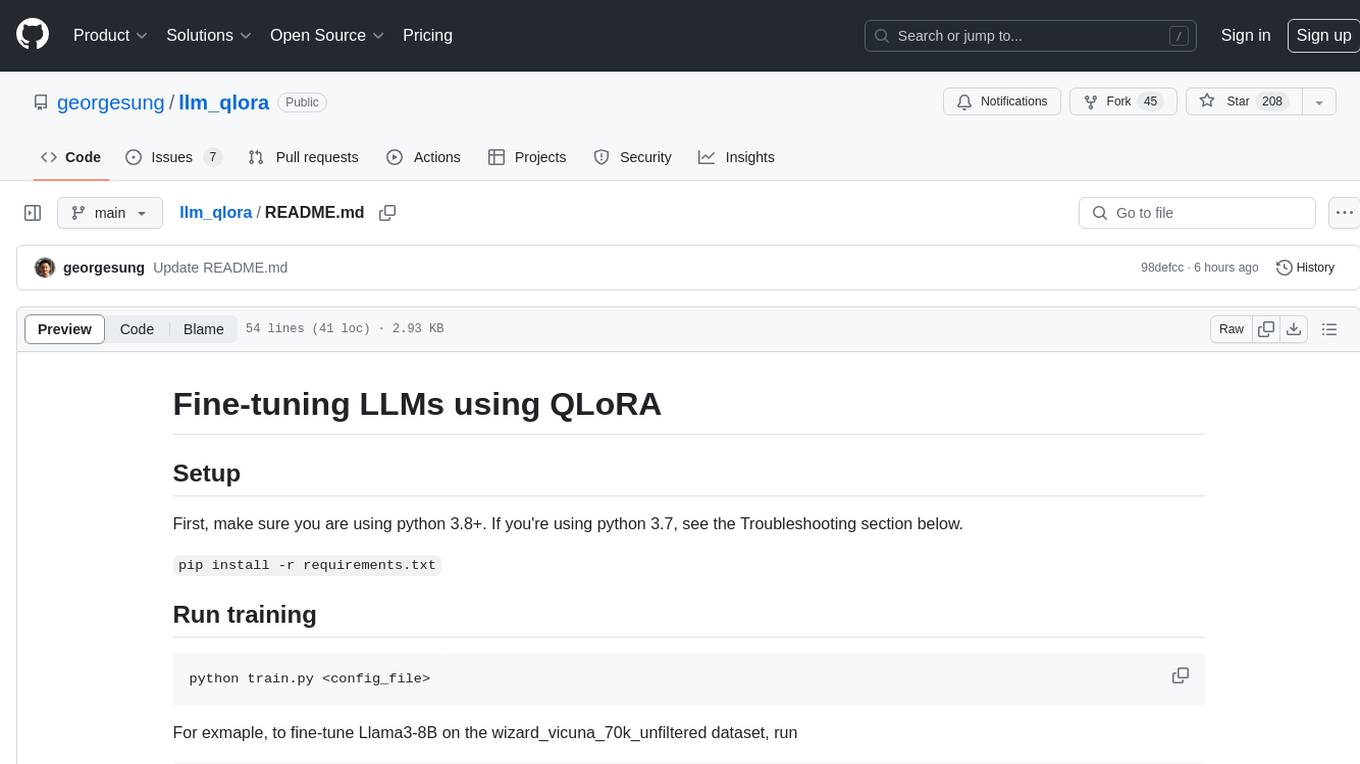
llm_qlora
LLM_QLoRA is a repository for fine-tuning Large Language Models (LLMs) using QLoRA methodology. It provides scripts for training LLMs on custom datasets, pushing models to HuggingFace Hub, and performing inference. Additionally, it includes models trained on HuggingFace Hub, a blog post detailing the QLoRA fine-tuning process, and instructions for converting and quantizing models. The repository also addresses troubleshooting issues related to Python versions and dependencies.
For similar jobs
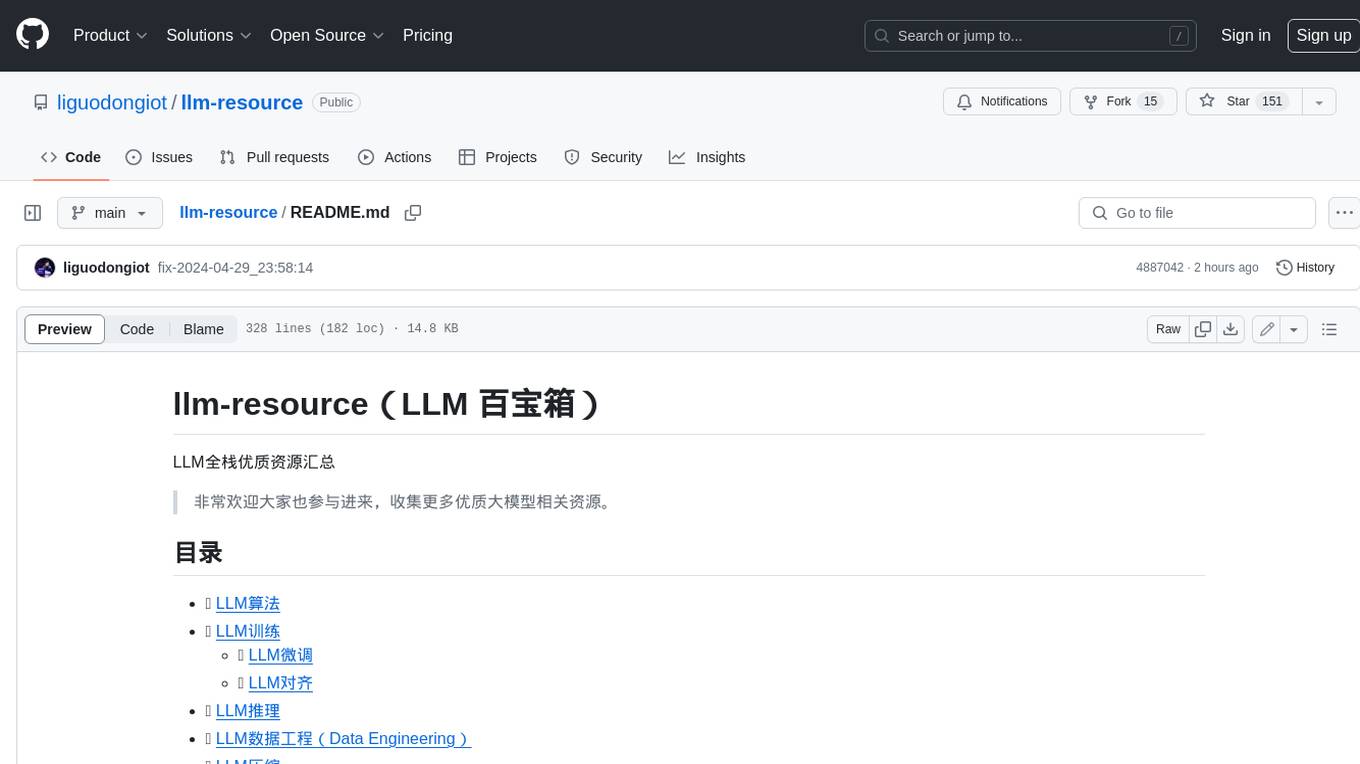
llm-resource
llm-resource is a comprehensive collection of high-quality resources for Large Language Models (LLM). It covers various aspects of LLM including algorithms, training, fine-tuning, alignment, inference, data engineering, compression, evaluation, prompt engineering, AI frameworks, AI basics, AI infrastructure, AI compilers, LLM application development, LLM operations, AI systems, and practical implementations. The repository aims to gather and share valuable resources related to LLM for the community to benefit from.
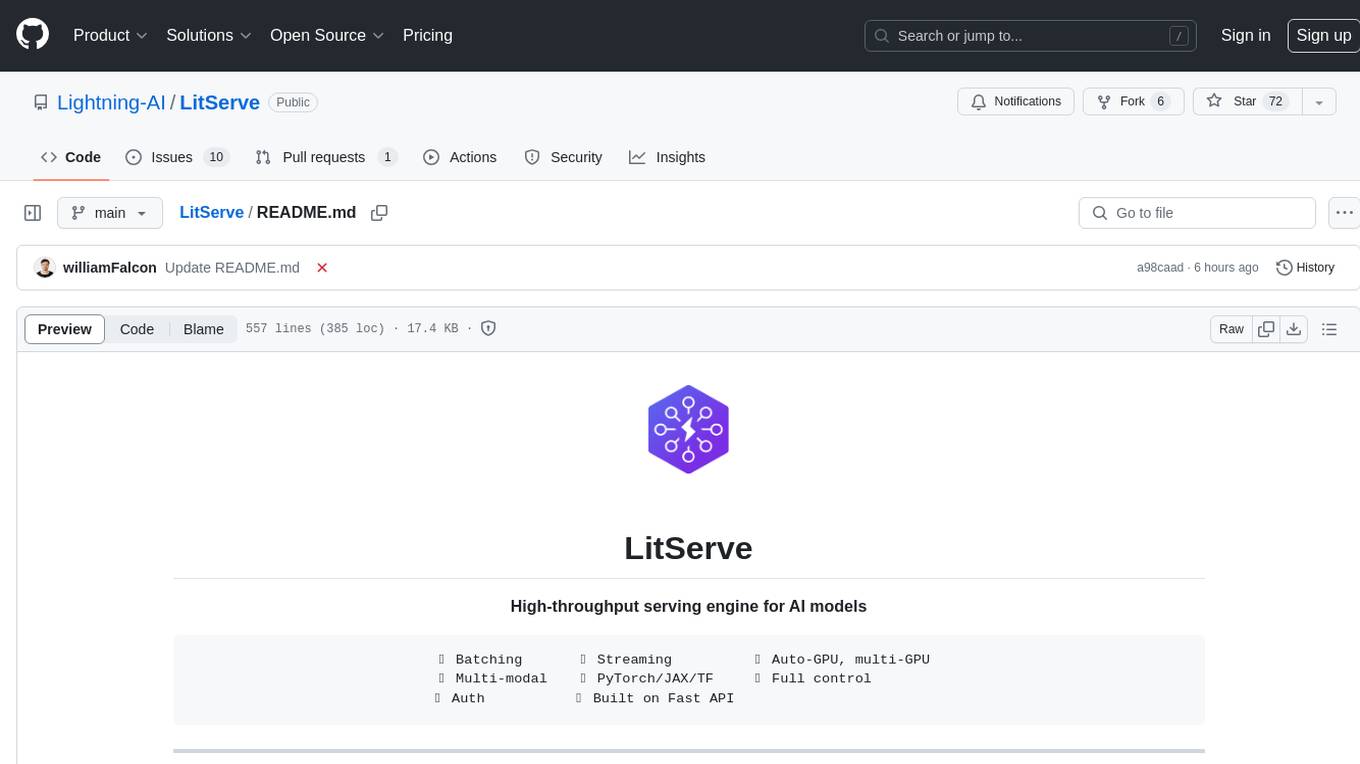
LitServe
LitServe is a high-throughput serving engine designed for deploying AI models at scale. It generates an API endpoint for models, handles batching, streaming, and autoscaling across CPU/GPUs. LitServe is built for enterprise scale with a focus on minimal, hackable code-base without bloat. It supports various model types like LLMs, vision, time-series, and works with frameworks like PyTorch, JAX, Tensorflow, and more. The tool allows users to focus on model performance rather than serving boilerplate, providing full control and flexibility.
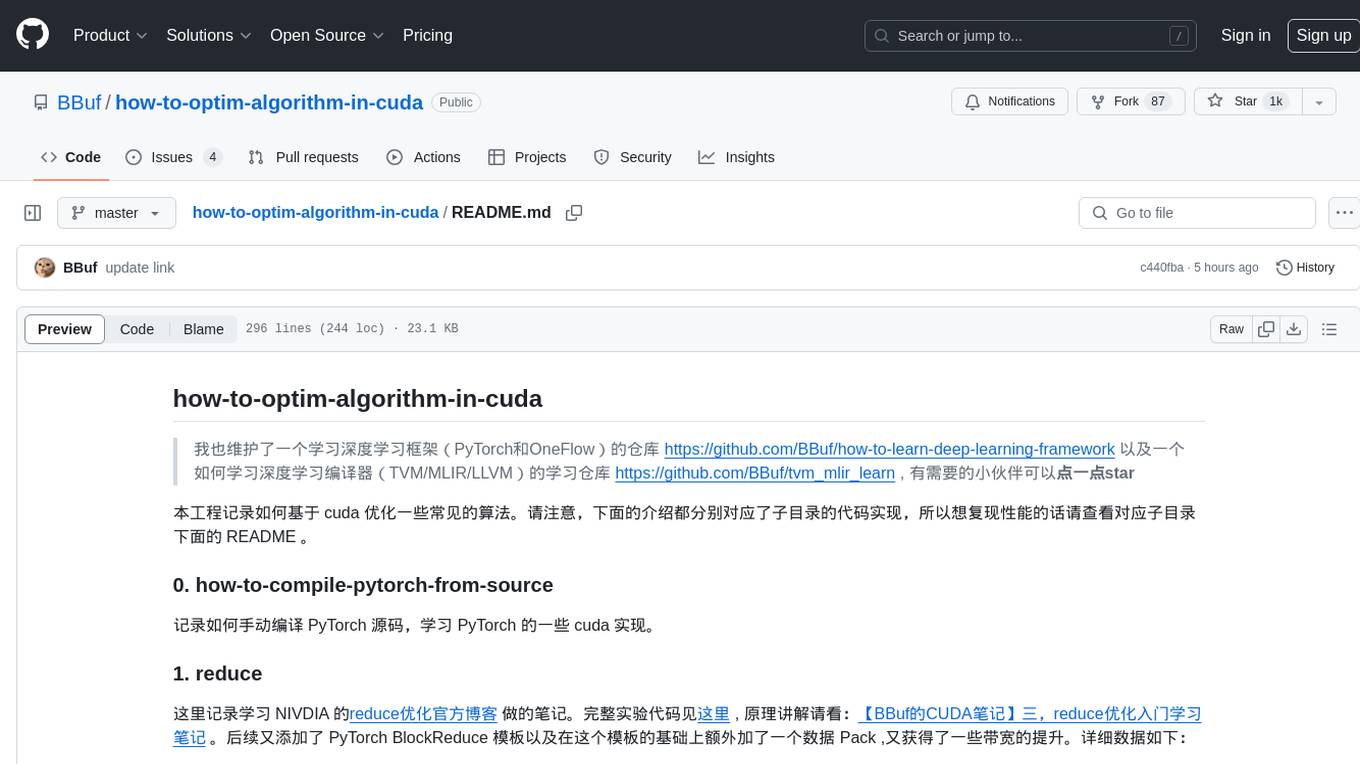
how-to-optim-algorithm-in-cuda
This repository documents how to optimize common algorithms based on CUDA. It includes subdirectories with code implementations for specific optimizations. The optimizations cover topics such as compiling PyTorch from source, NVIDIA's reduce optimization, OneFlow's elementwise template, fast atomic add for half data types, upsample nearest2d optimization in OneFlow, optimized indexing in PyTorch, OneFlow's softmax kernel, linear attention optimization, and more. The repository also includes learning resources related to deep learning frameworks, compilers, and optimization techniques.
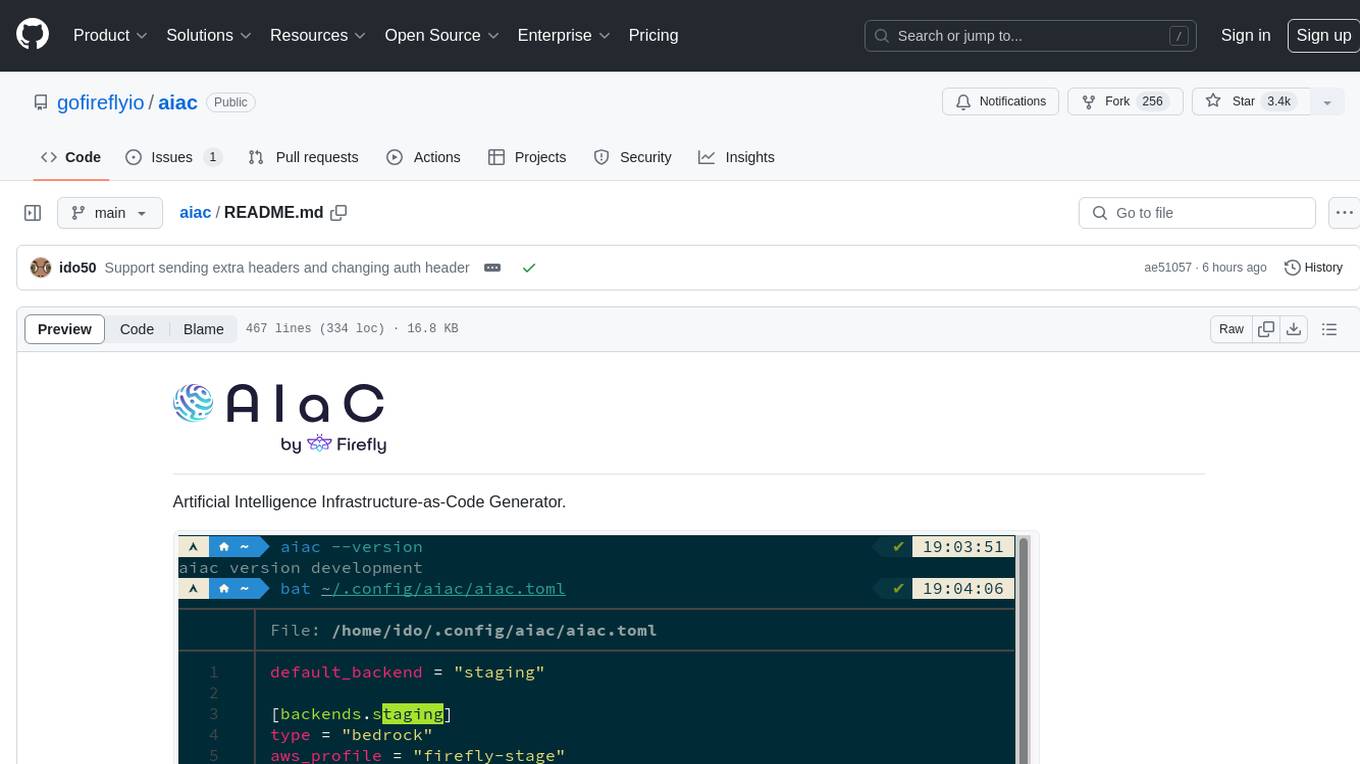
aiac
AIAC is a library and command line tool to generate Infrastructure as Code (IaC) templates, configurations, utilities, queries, and more via LLM providers such as OpenAI, Amazon Bedrock, and Ollama. Users can define multiple 'backends' targeting different LLM providers and environments using a simple configuration file. The tool allows users to ask a model to generate templates for different scenarios and composes an appropriate request to the selected provider, storing the resulting code to a file and/or printing it to standard output.
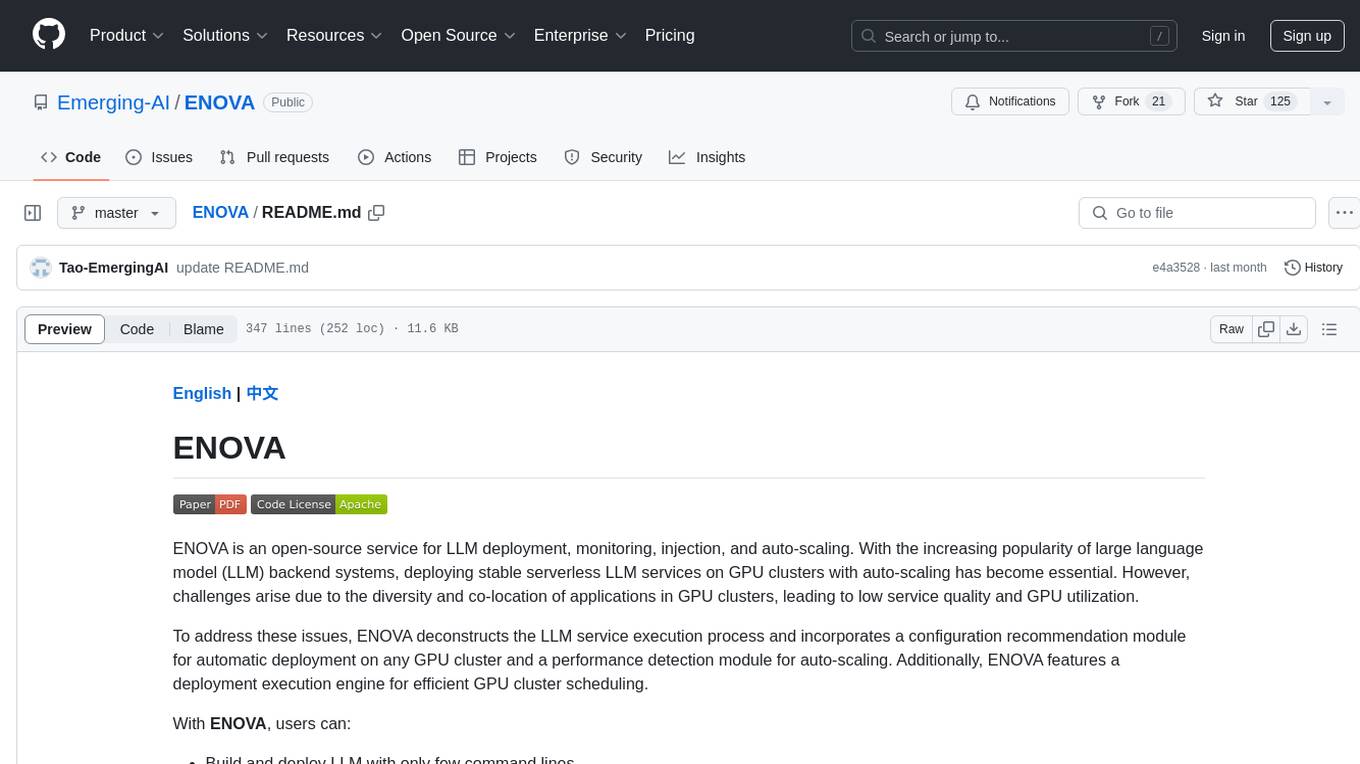
ENOVA
ENOVA is an open-source service for Large Language Model (LLM) deployment, monitoring, injection, and auto-scaling. It addresses challenges in deploying stable serverless LLM services on GPU clusters with auto-scaling by deconstructing the LLM service execution process and providing configuration recommendations and performance detection. Users can build and deploy LLM with few command lines, recommend optimal computing resources, experience LLM performance, observe operating status, achieve load balancing, and more. ENOVA ensures stable operation, cost-effectiveness, efficiency, and strong scalability of LLM services.
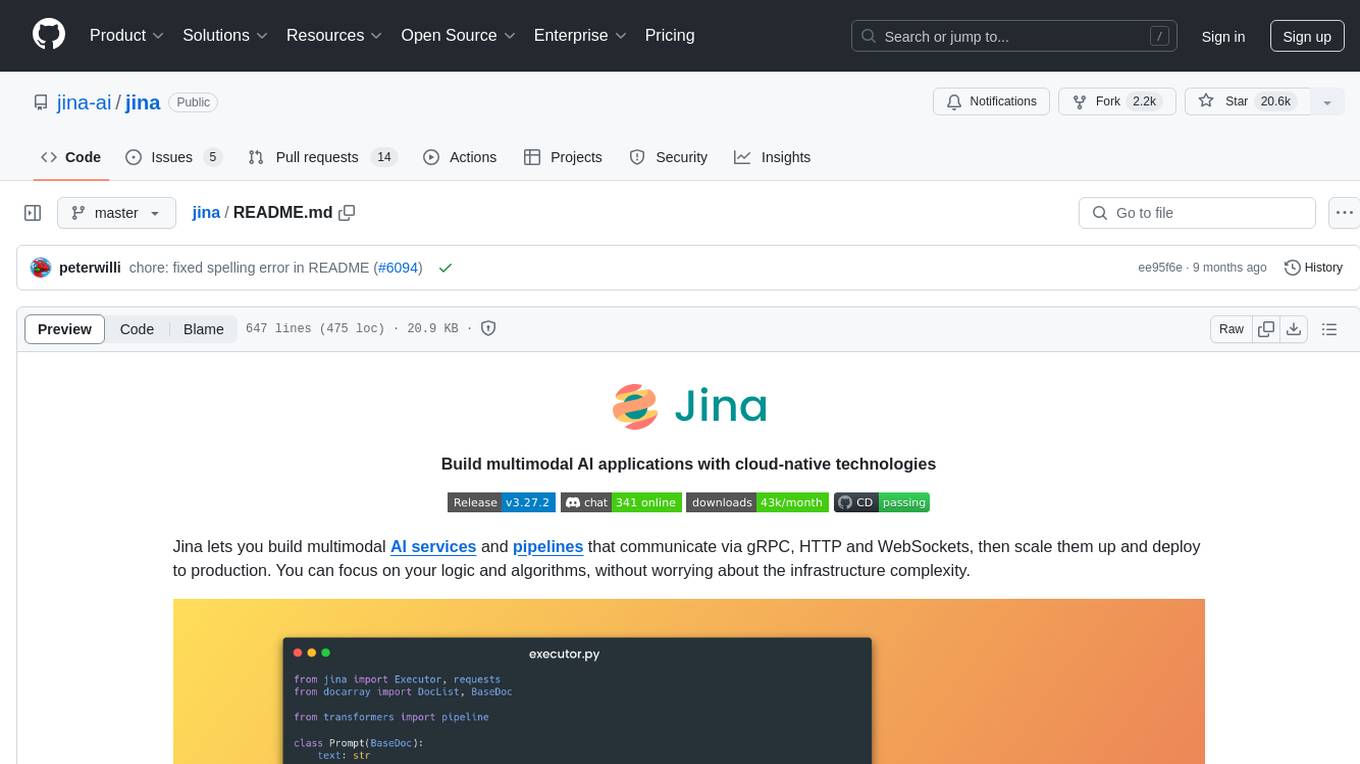
jina
Jina is a tool that allows users to build multimodal AI services and pipelines using cloud-native technologies. It provides a Pythonic experience for serving ML models and transitioning from local deployment to advanced orchestration frameworks like Docker-Compose, Kubernetes, or Jina AI Cloud. Users can build and serve models for any data type and deep learning framework, design high-performance services with easy scaling, serve LLM models while streaming their output, integrate with Docker containers via Executor Hub, and host on CPU/GPU using Jina AI Cloud. Jina also offers advanced orchestration and scaling capabilities, a smooth transition to the cloud, and easy scalability and concurrency features for applications. Users can deploy to their own cloud or system with Kubernetes and Docker Compose integration, and even deploy to JCloud for autoscaling and monitoring.
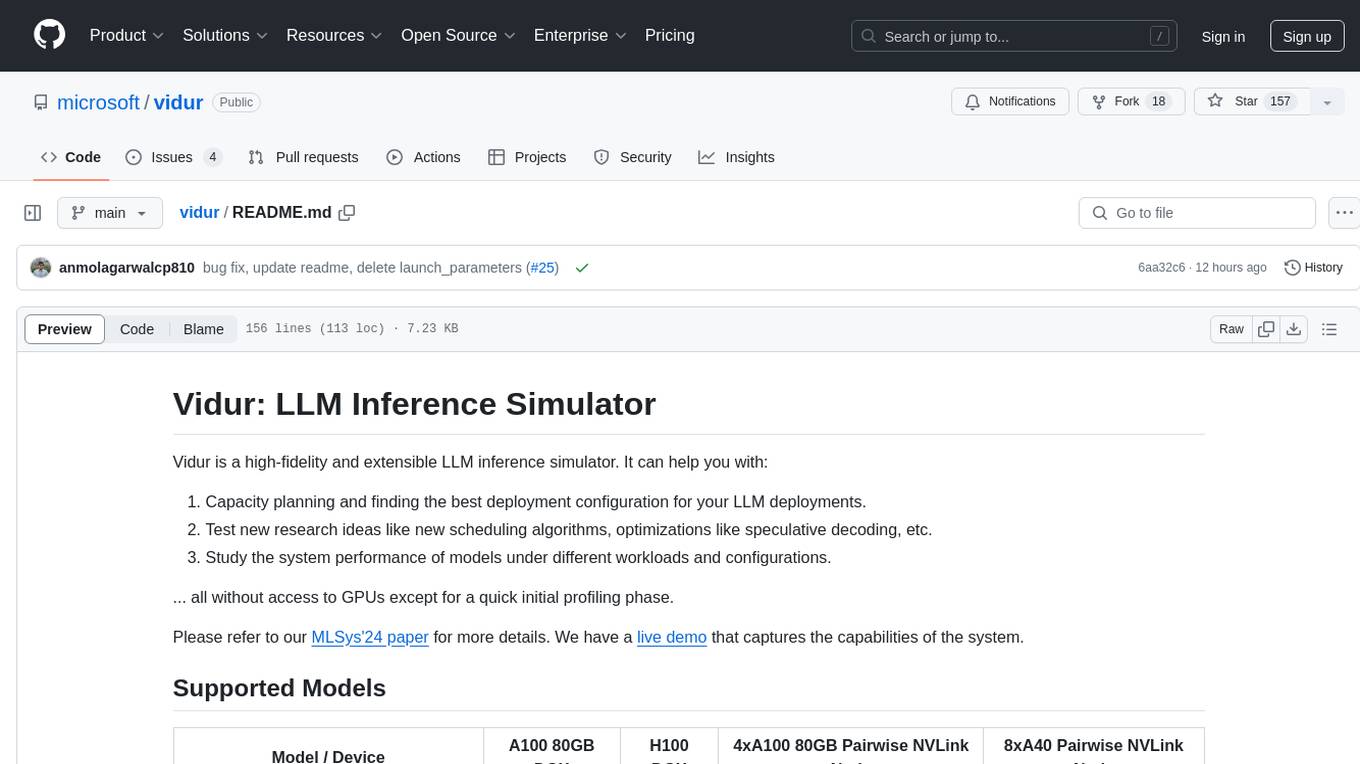
vidur
Vidur is a high-fidelity and extensible LLM inference simulator designed for capacity planning, deployment configuration optimization, testing new research ideas, and studying system performance of models under different workloads and configurations. It supports various models and devices, offers chrome trace exports, and can be set up using mamba, venv, or conda. Users can run the simulator with various parameters and monitor metrics using wandb. Contributions are welcome, subject to a Contributor License Agreement and adherence to the Microsoft Open Source Code of Conduct.
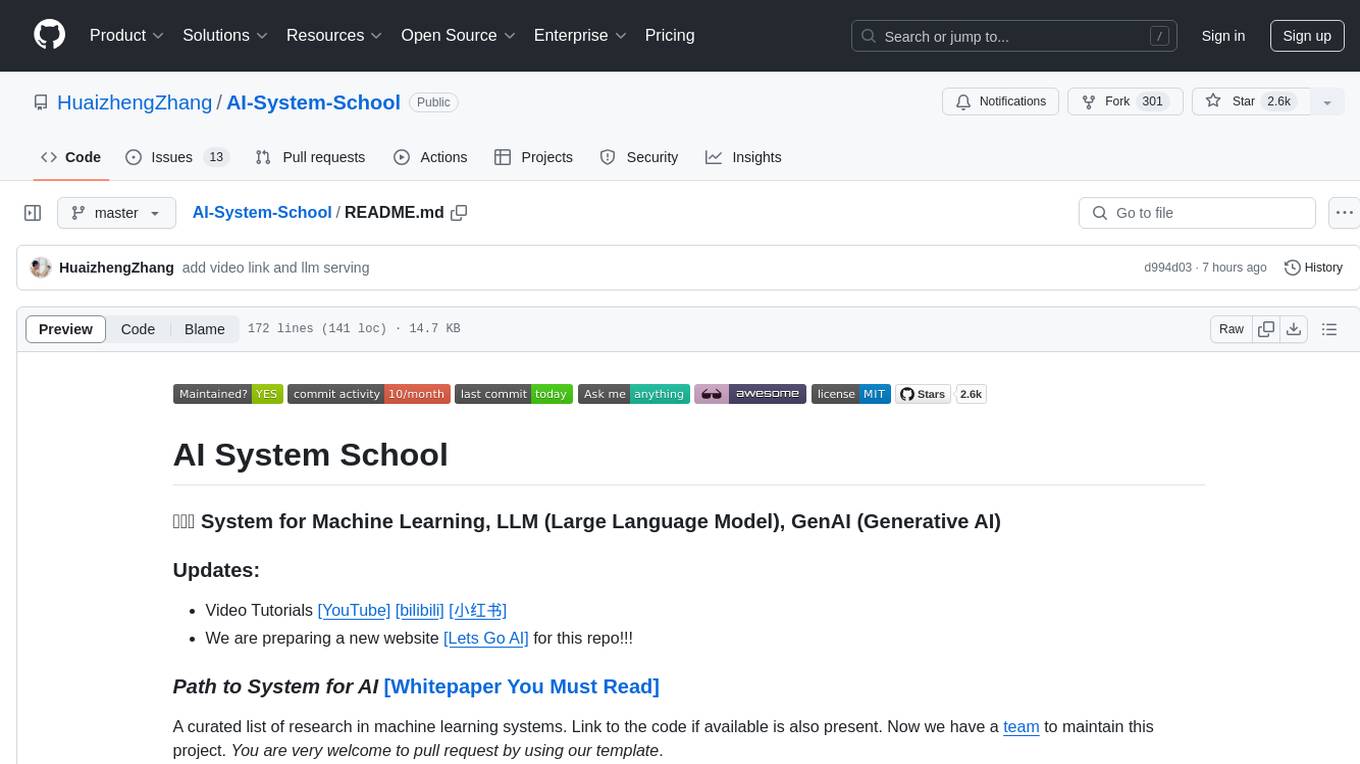
AI-System-School
AI System School is a curated list of research in machine learning systems, focusing on ML/DL infra, LLM infra, domain-specific infra, ML/LLM conferences, and general resources. It provides resources such as data processing, training systems, video systems, autoML systems, and more. The repository aims to help users navigate the landscape of AI systems and machine learning infrastructure, offering insights into conferences, surveys, books, videos, courses, and blogs related to the field.




